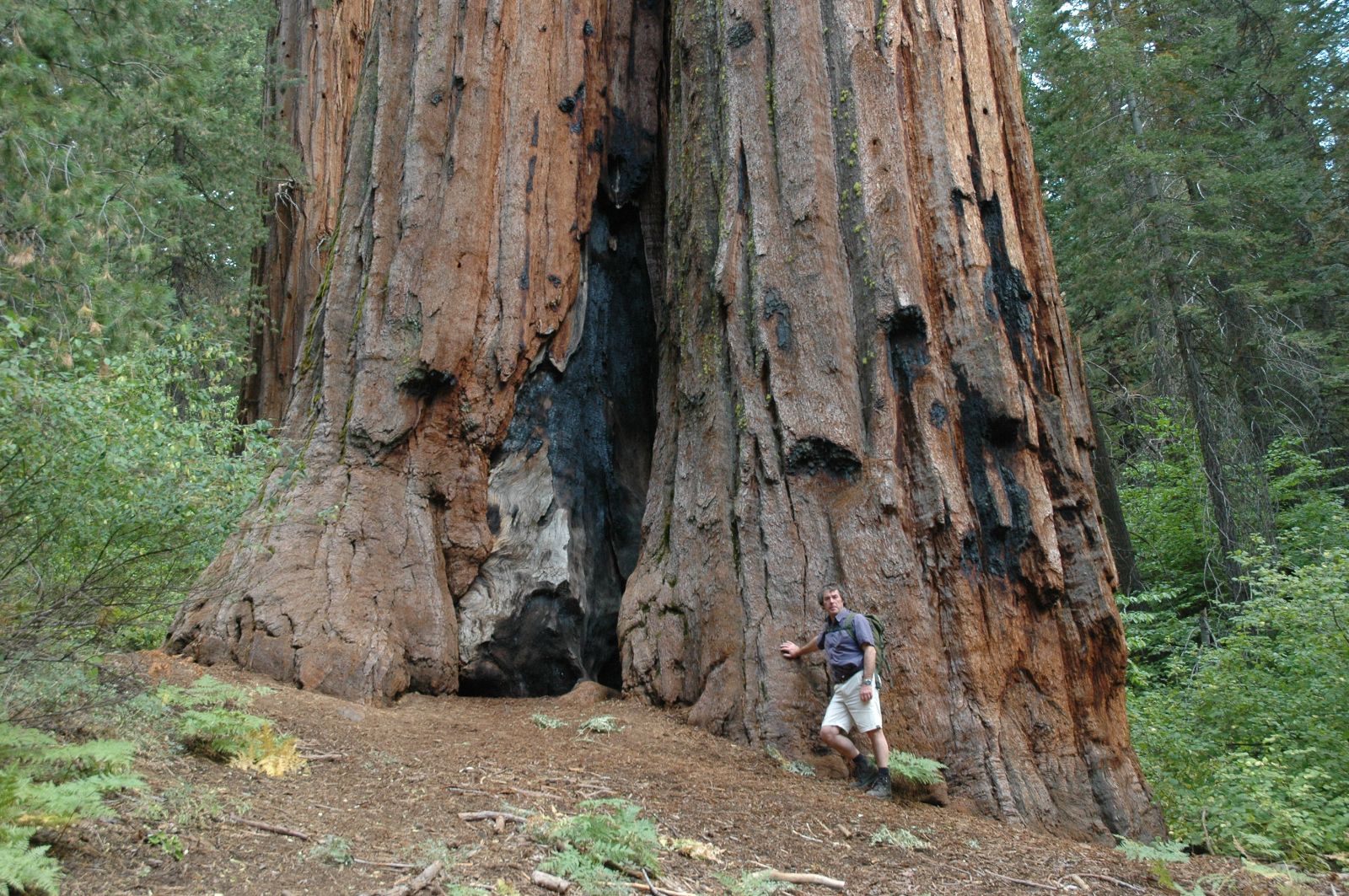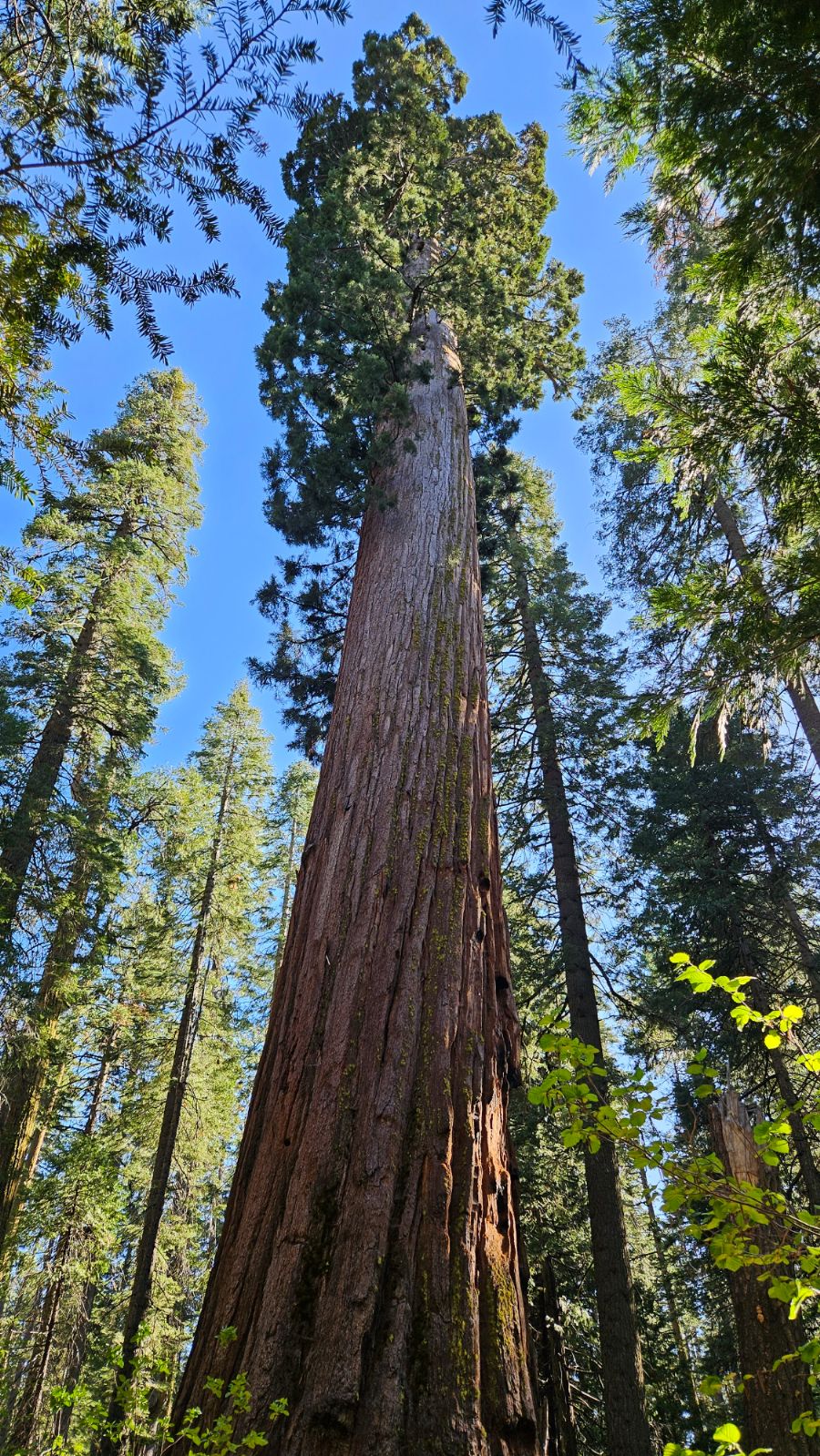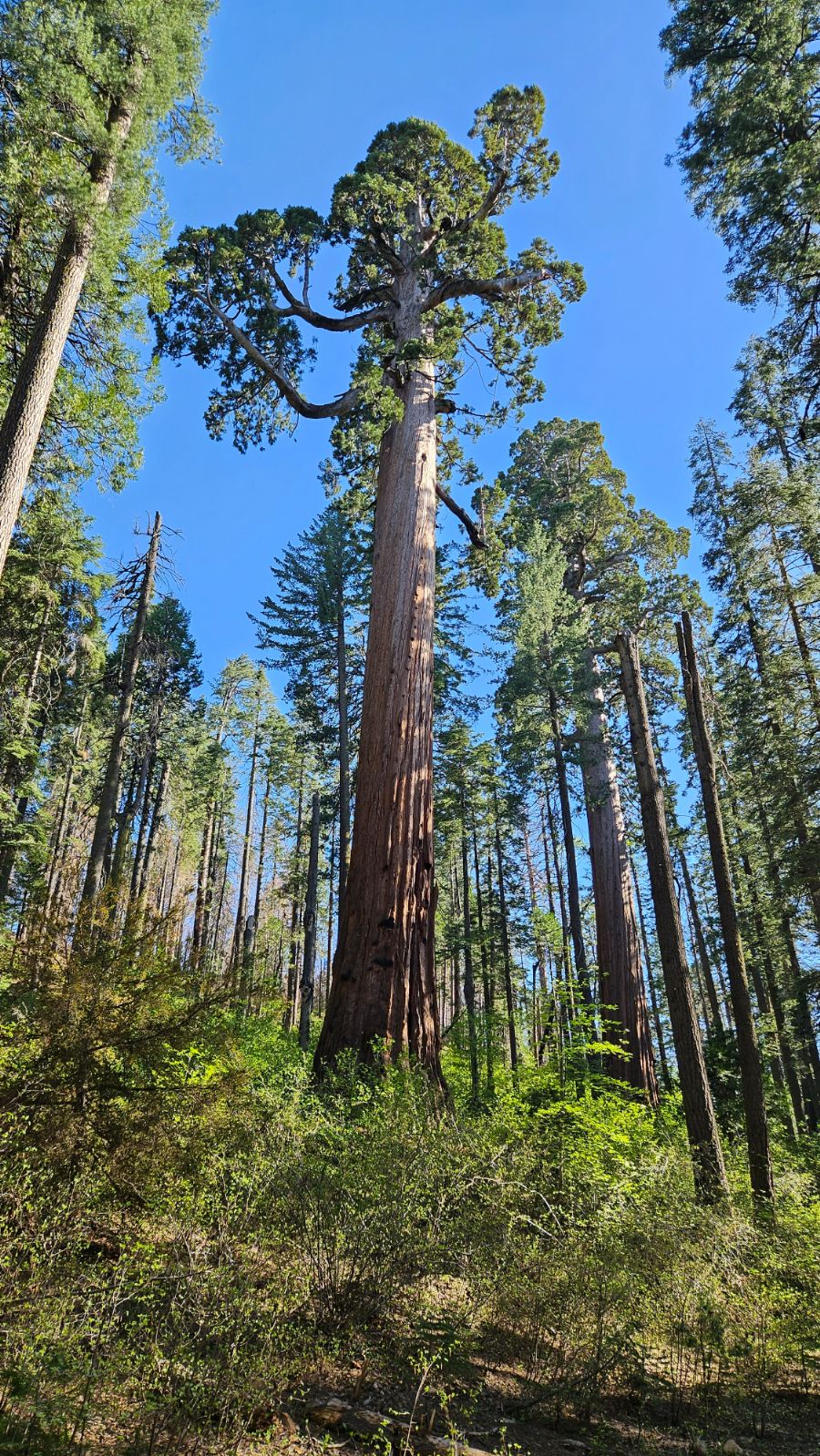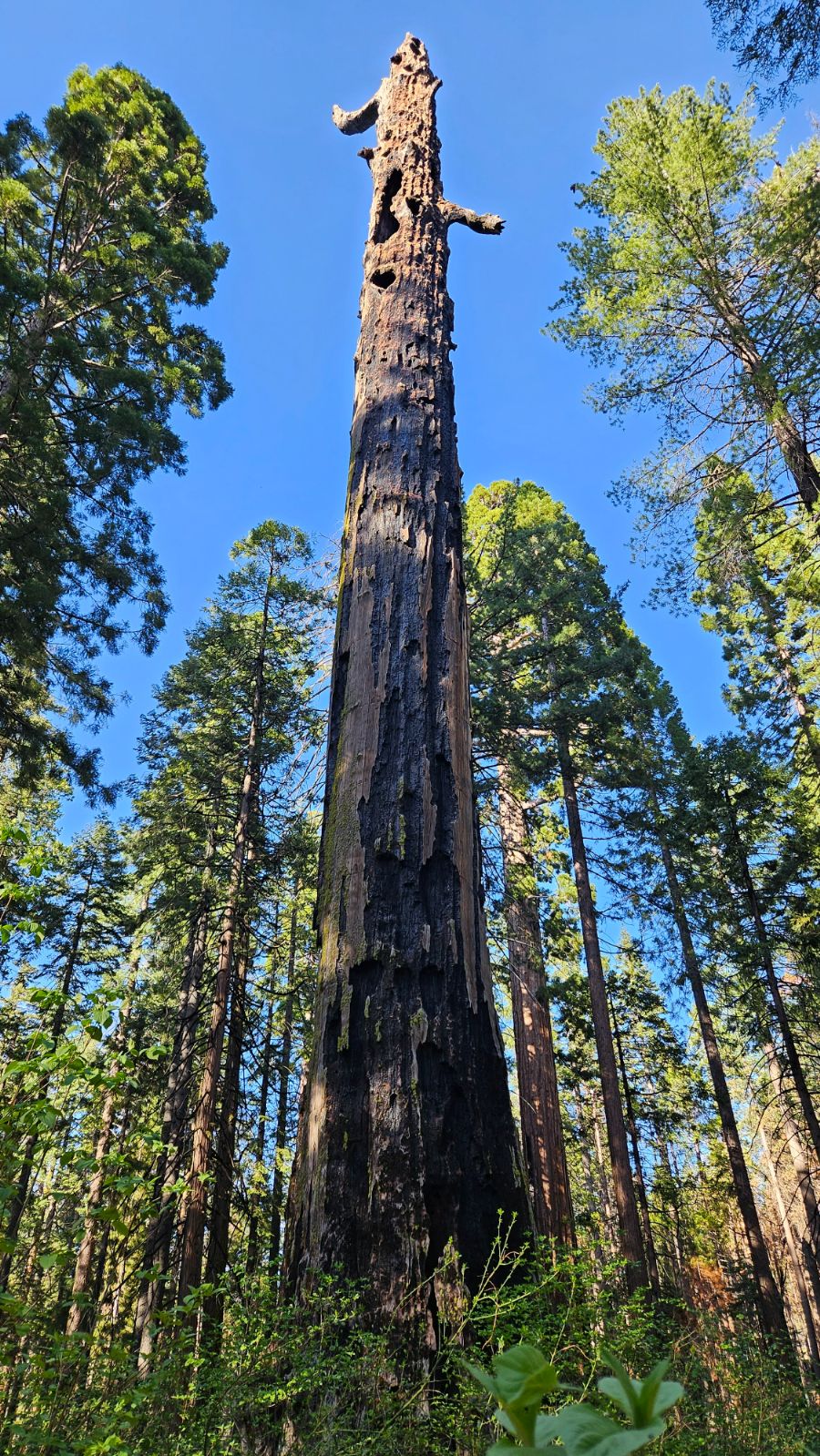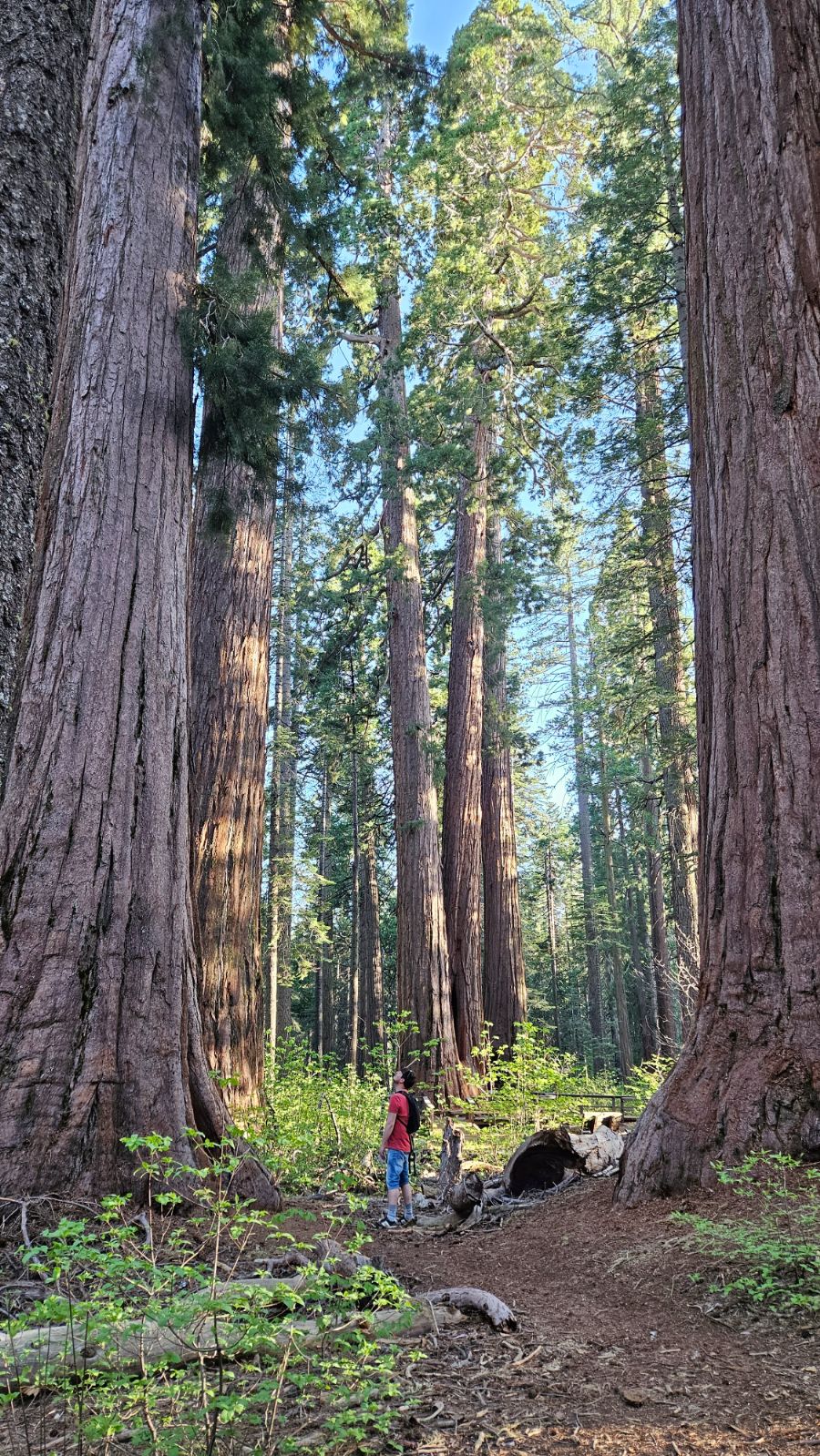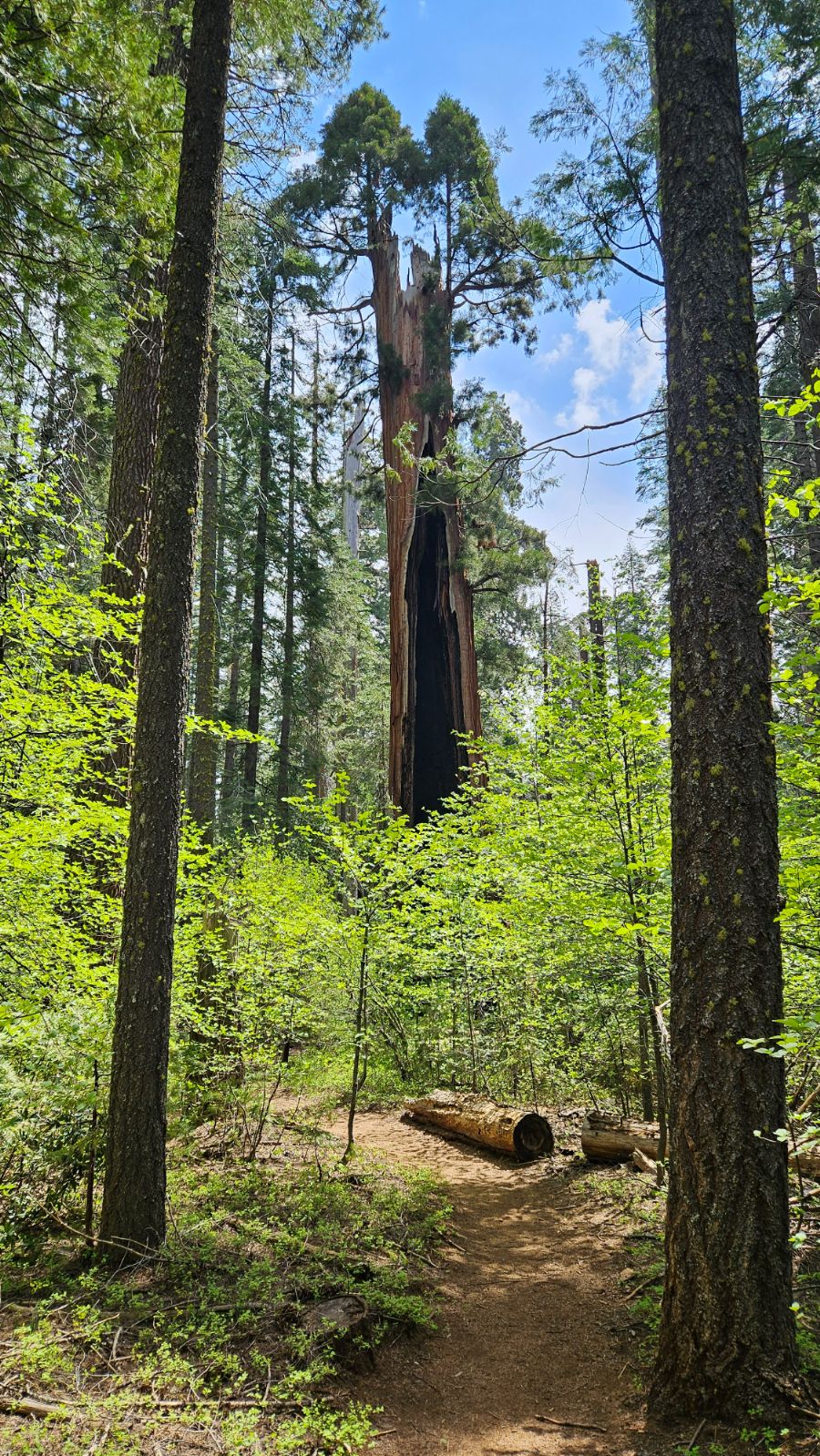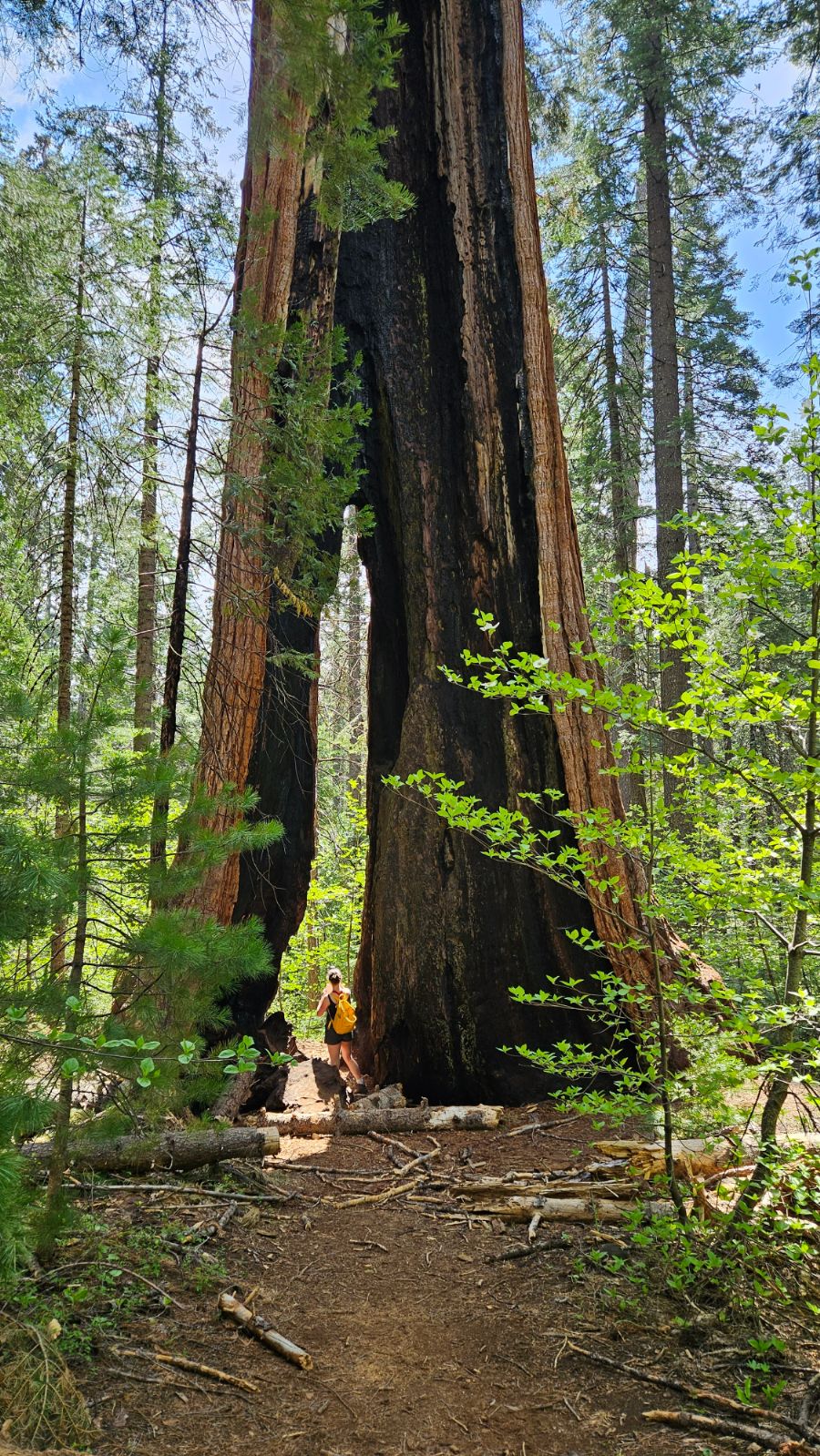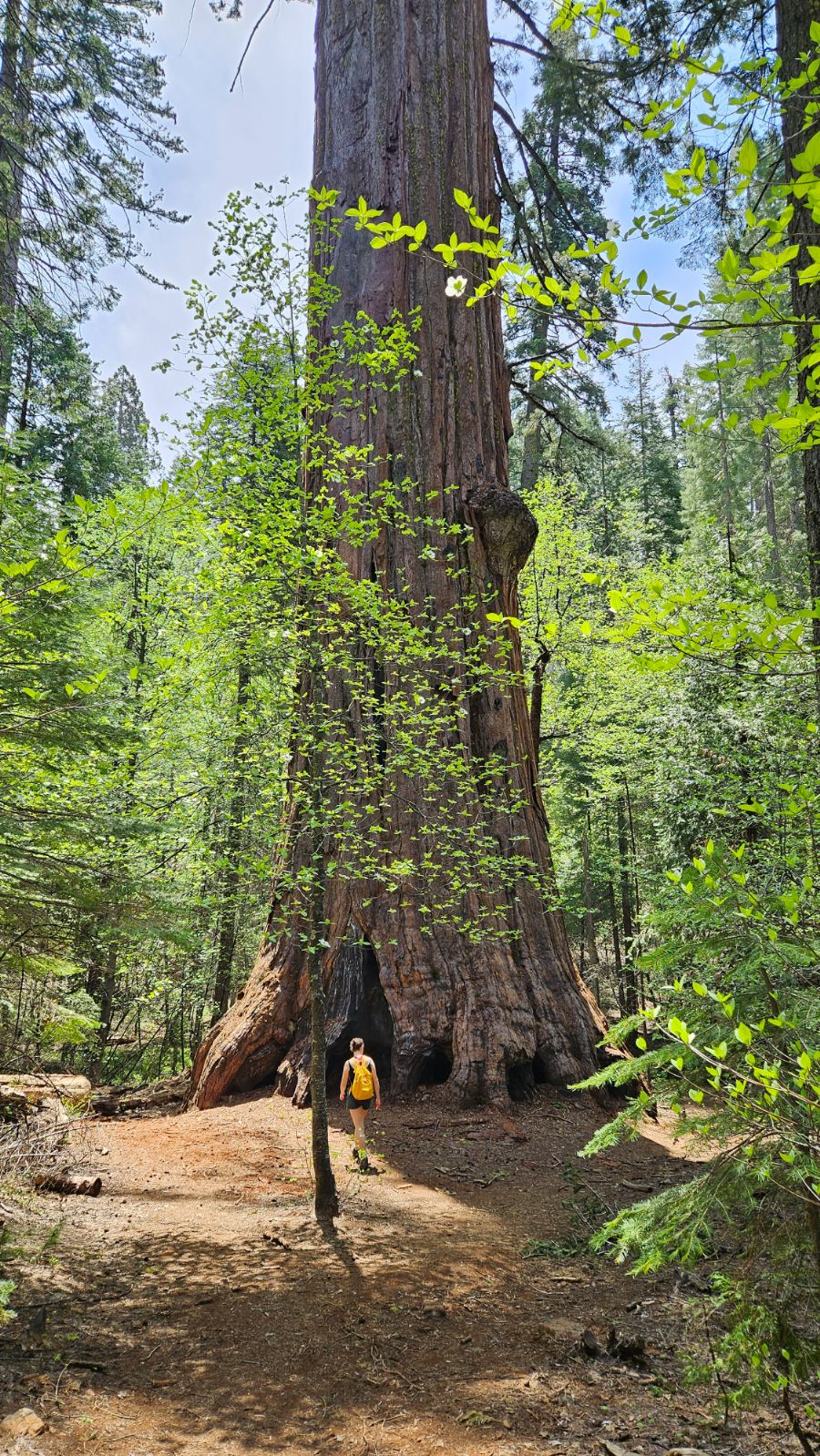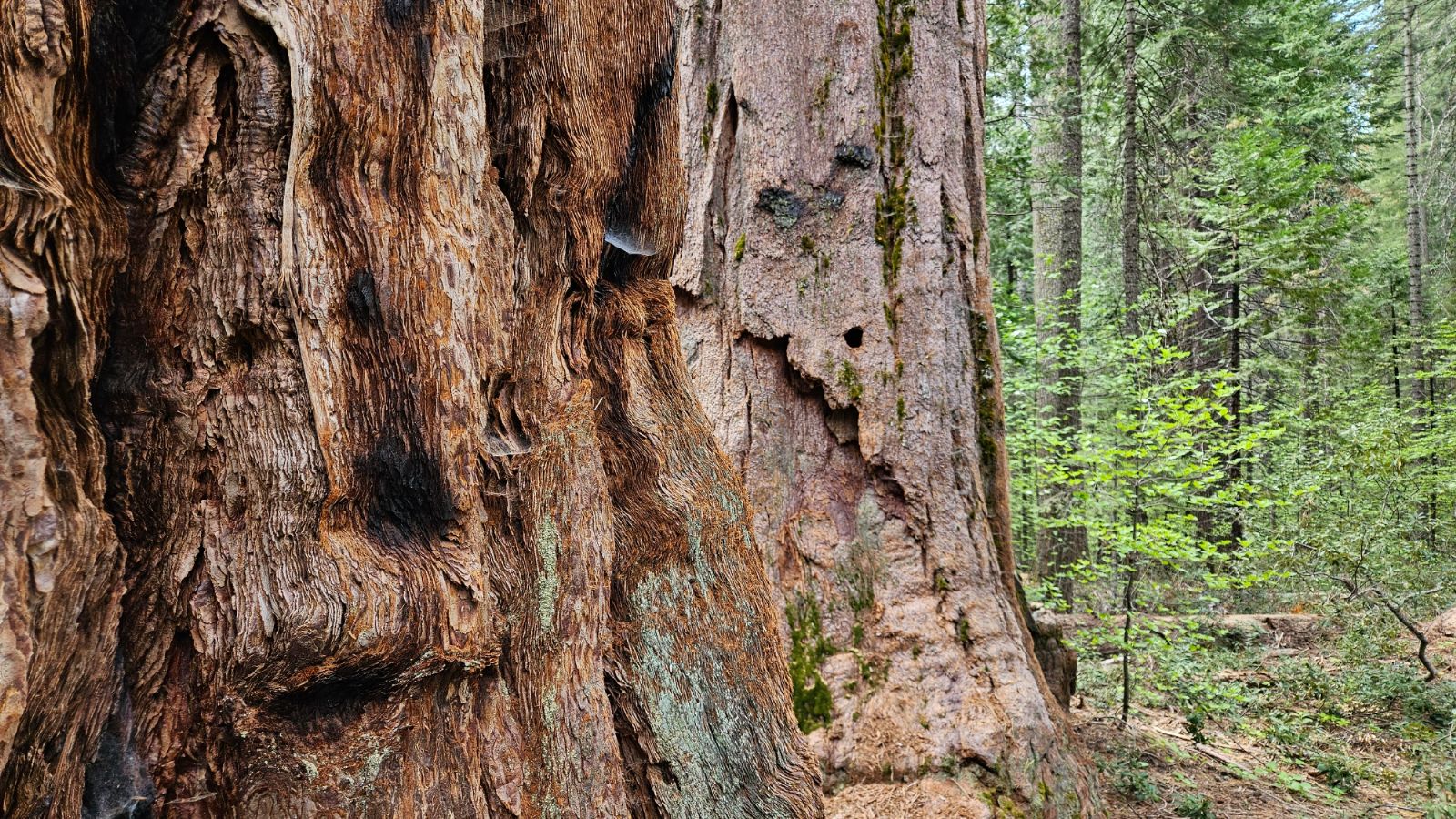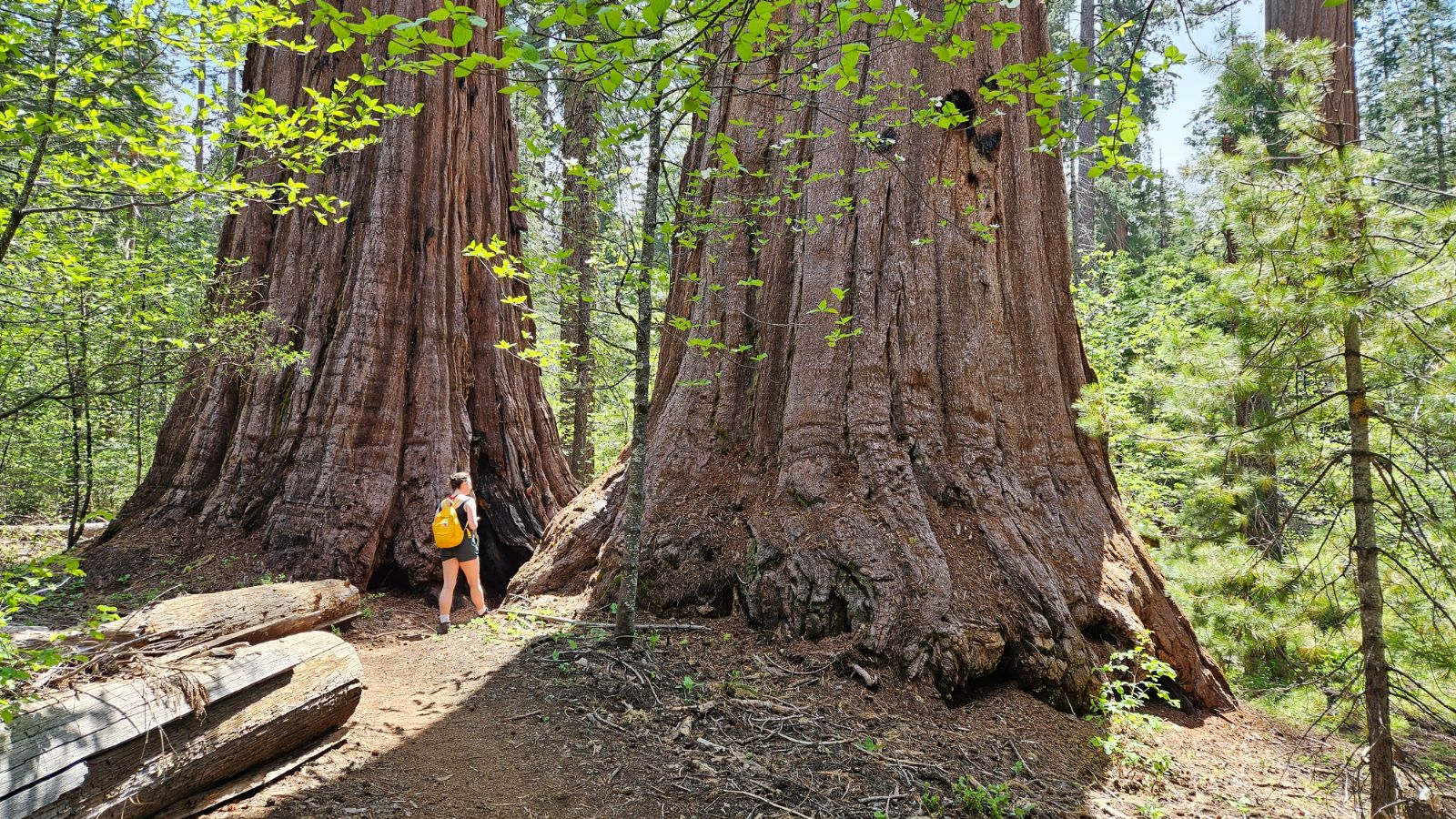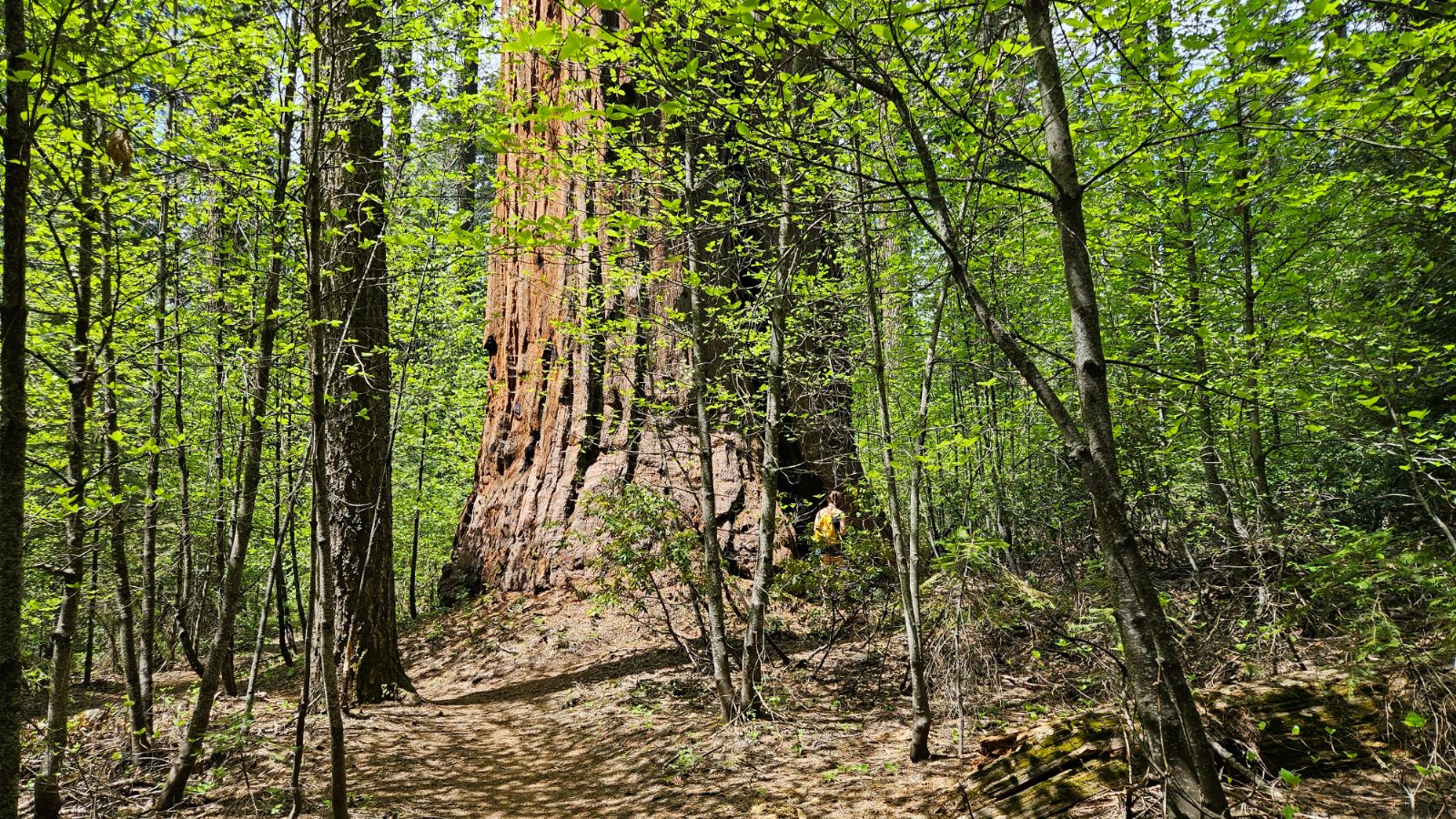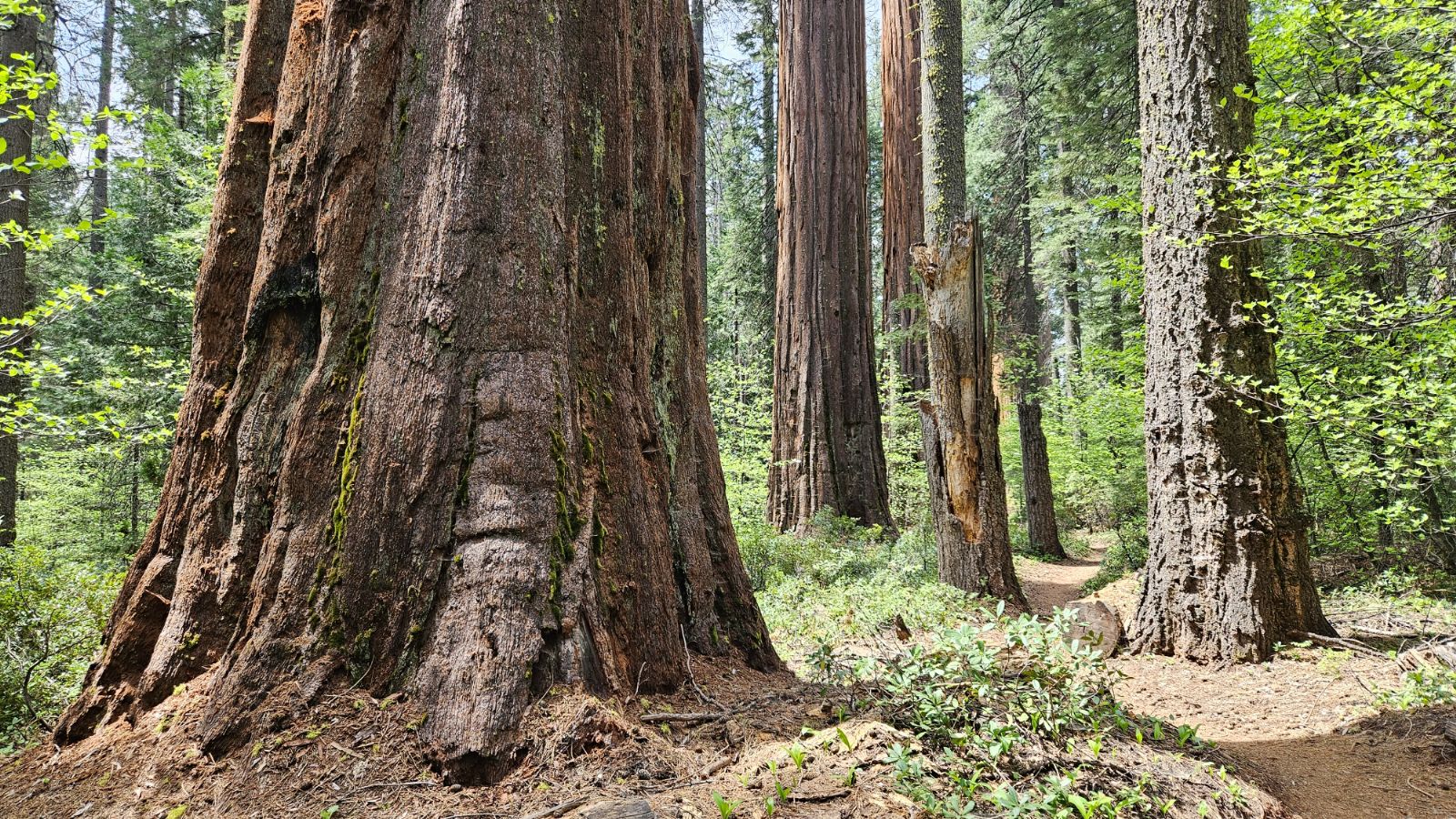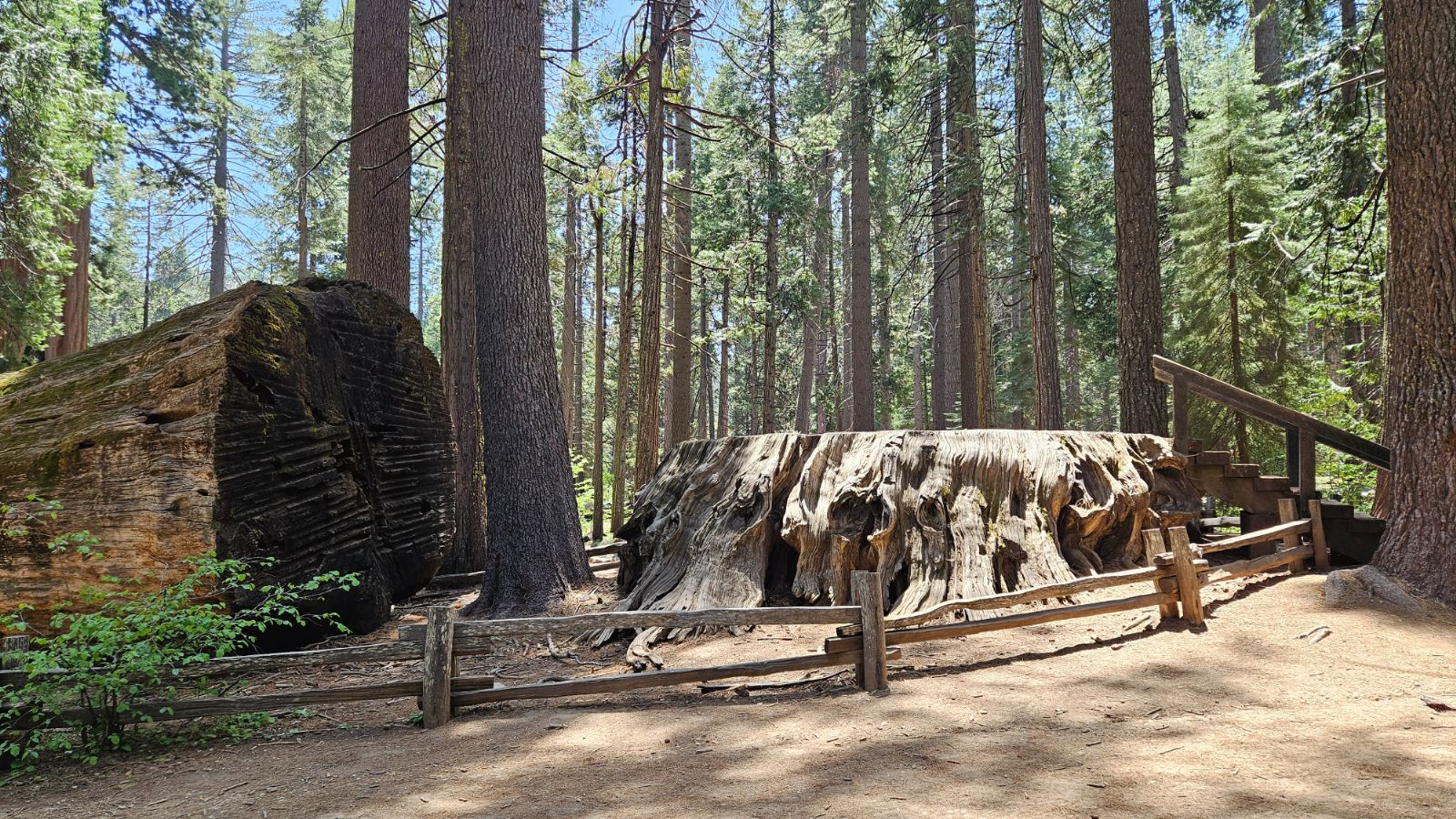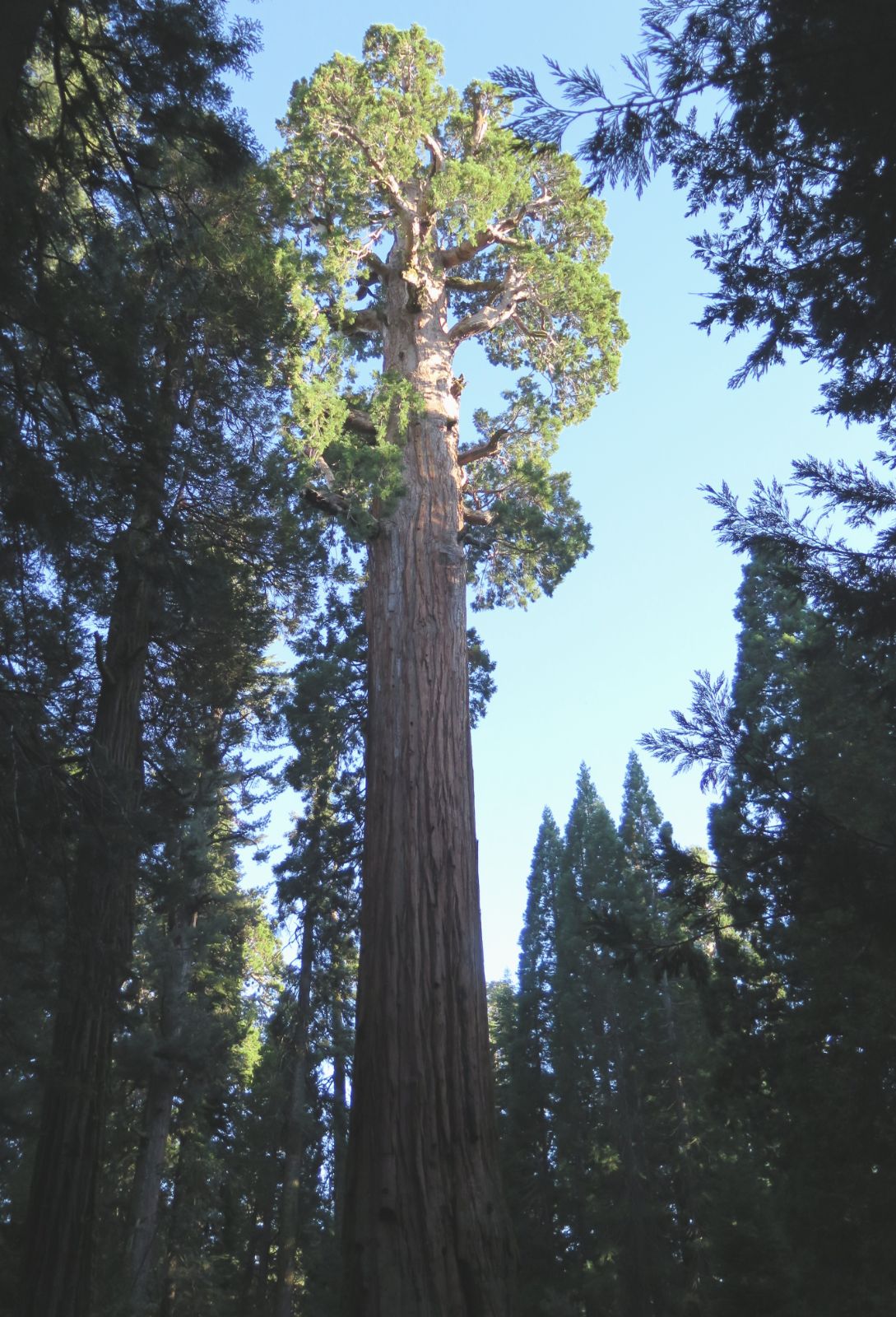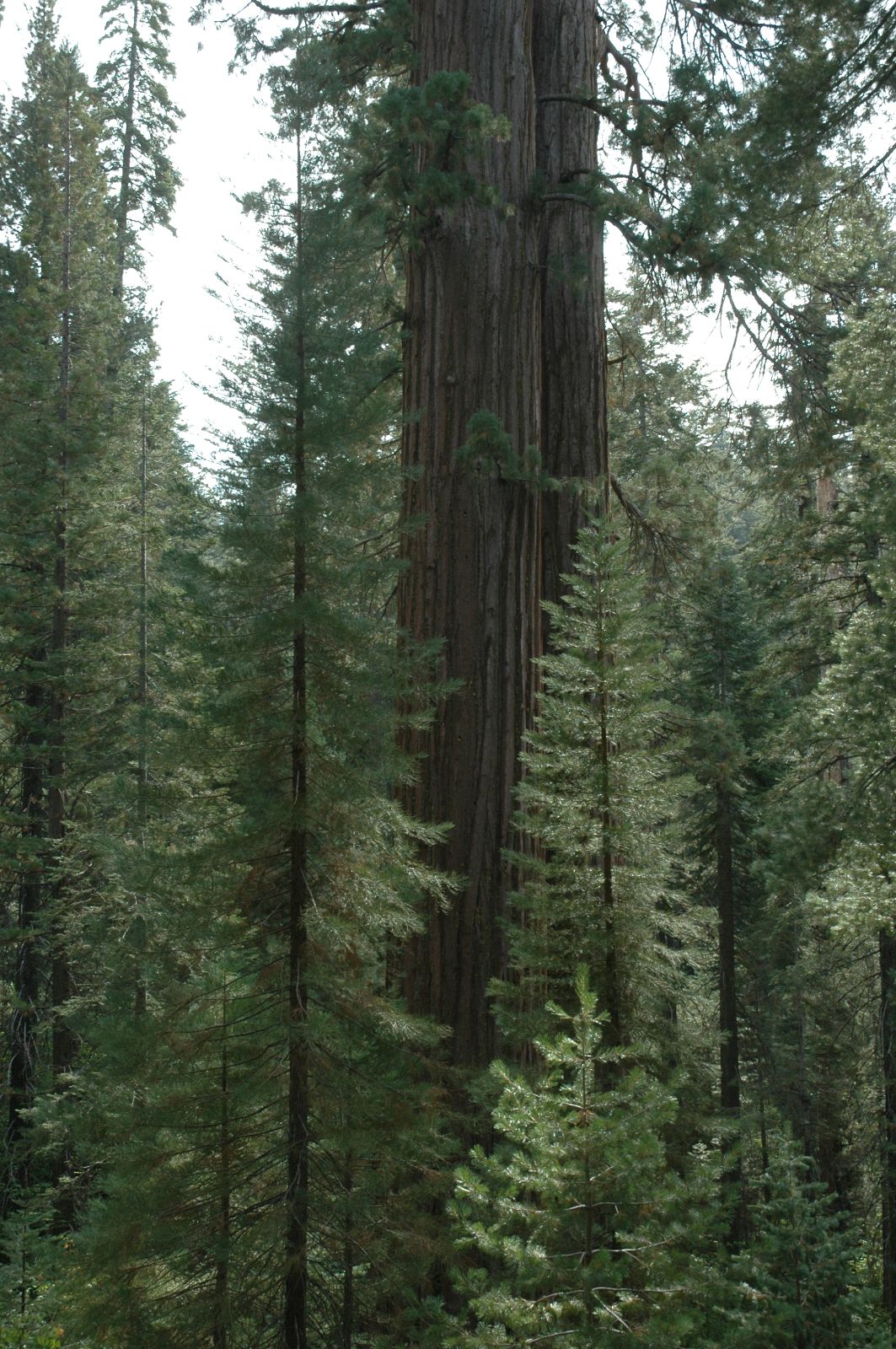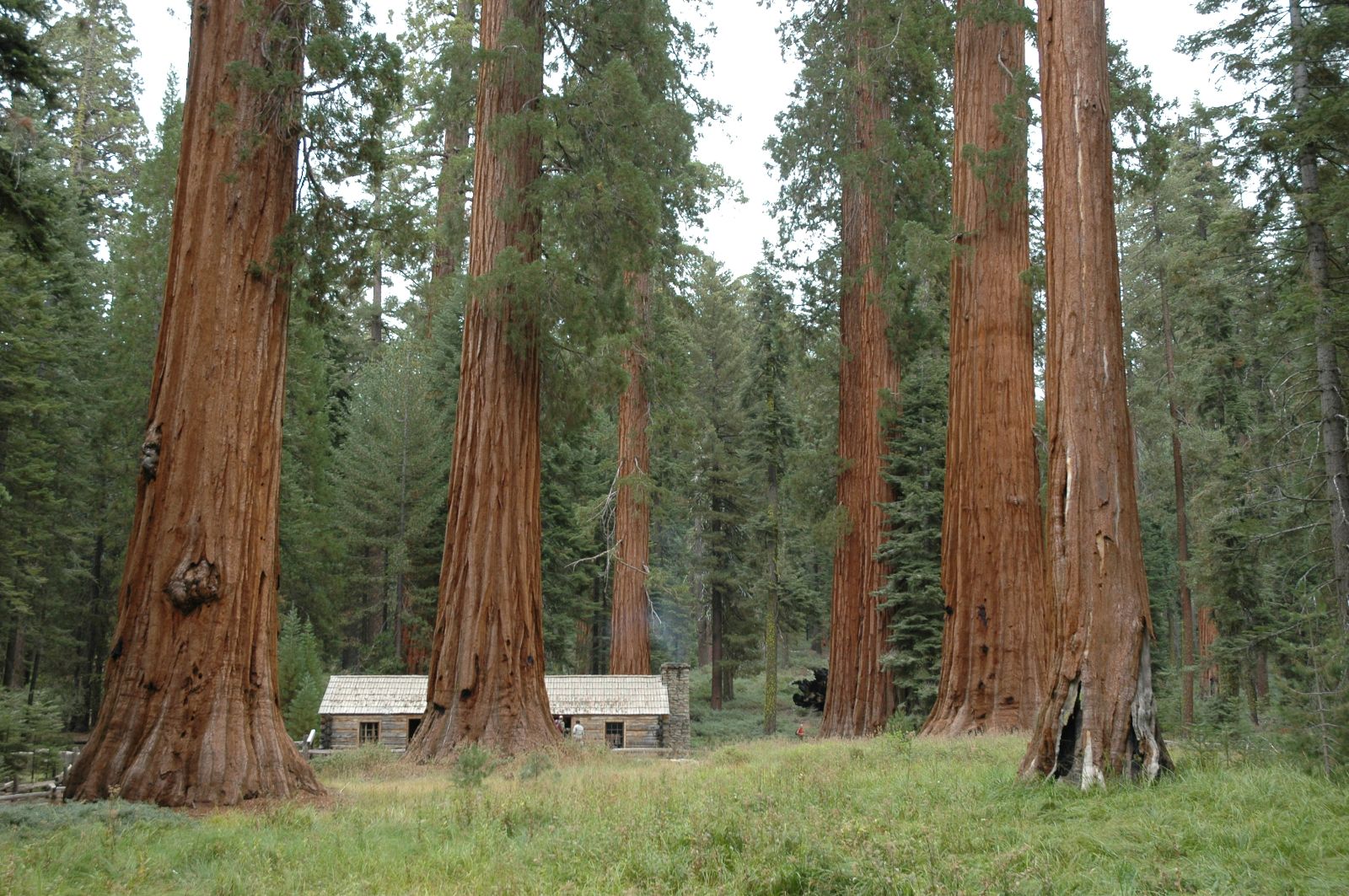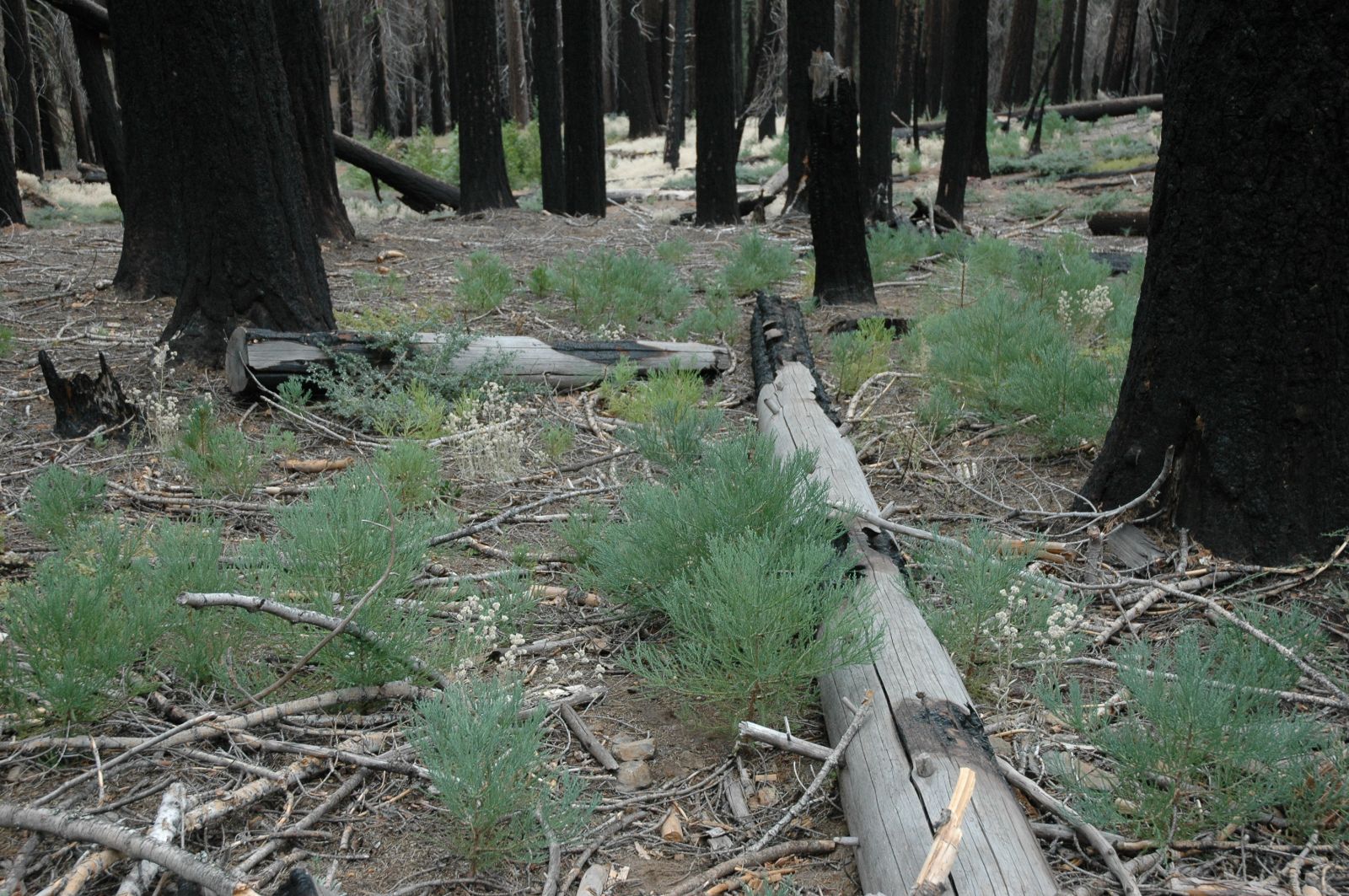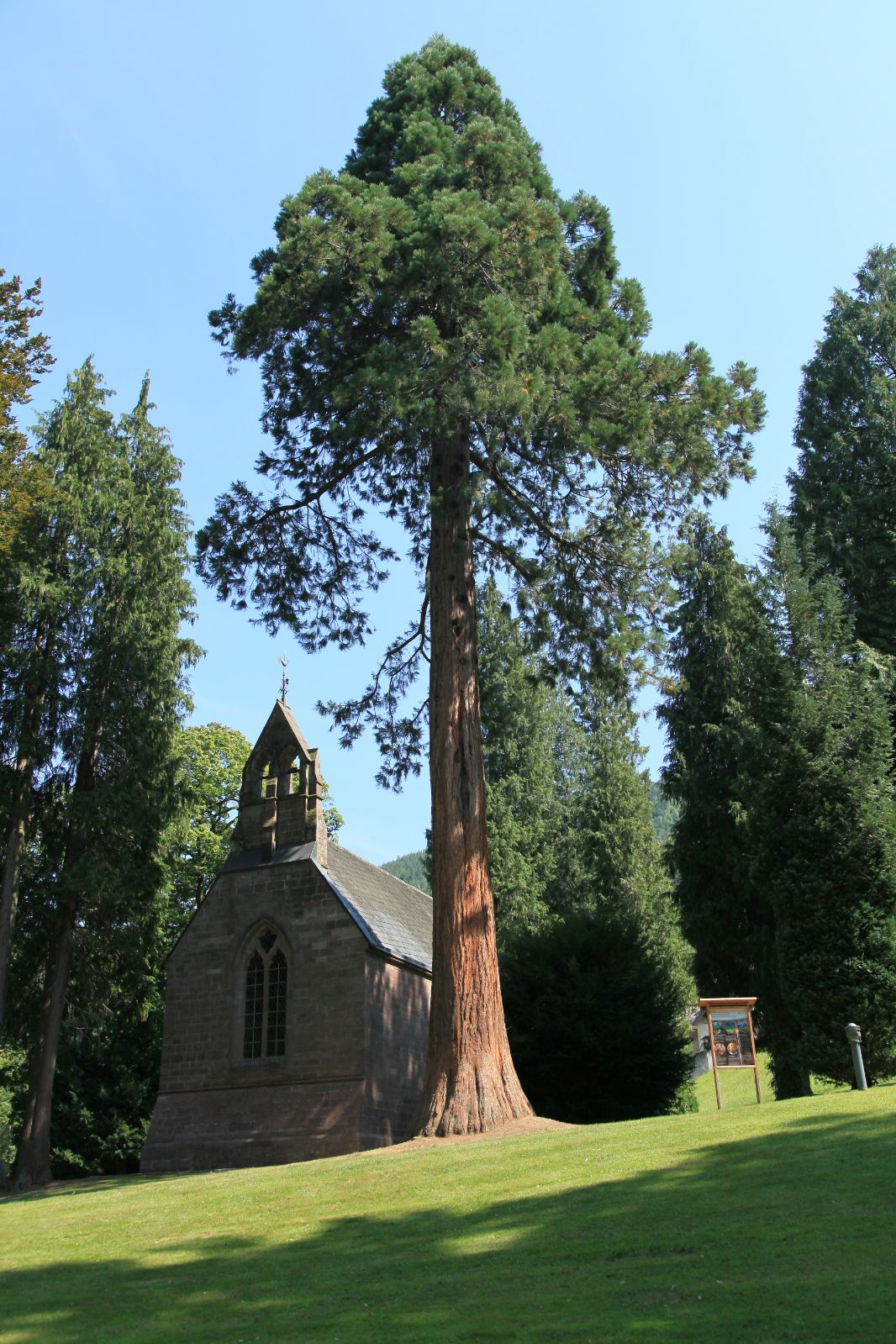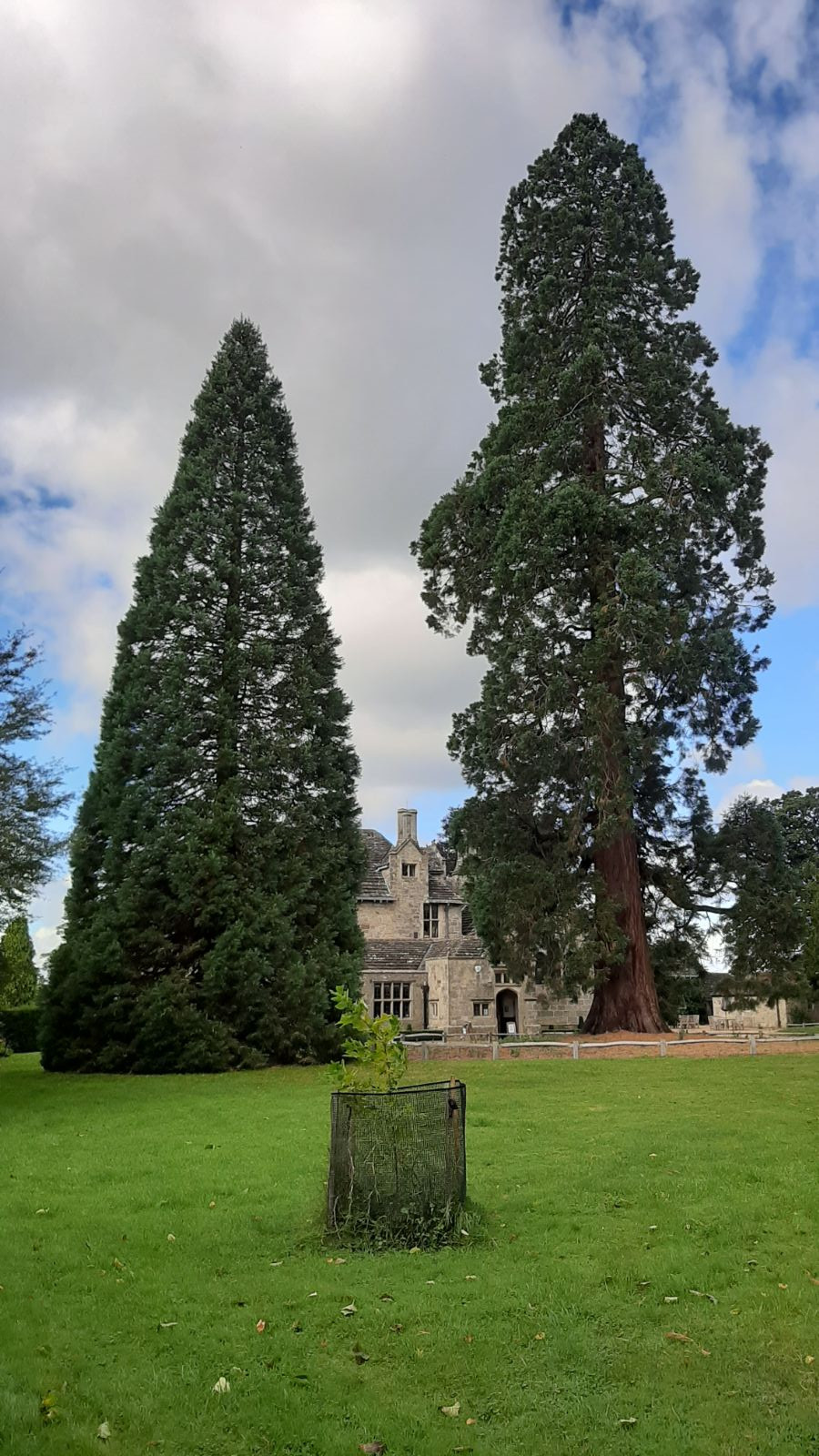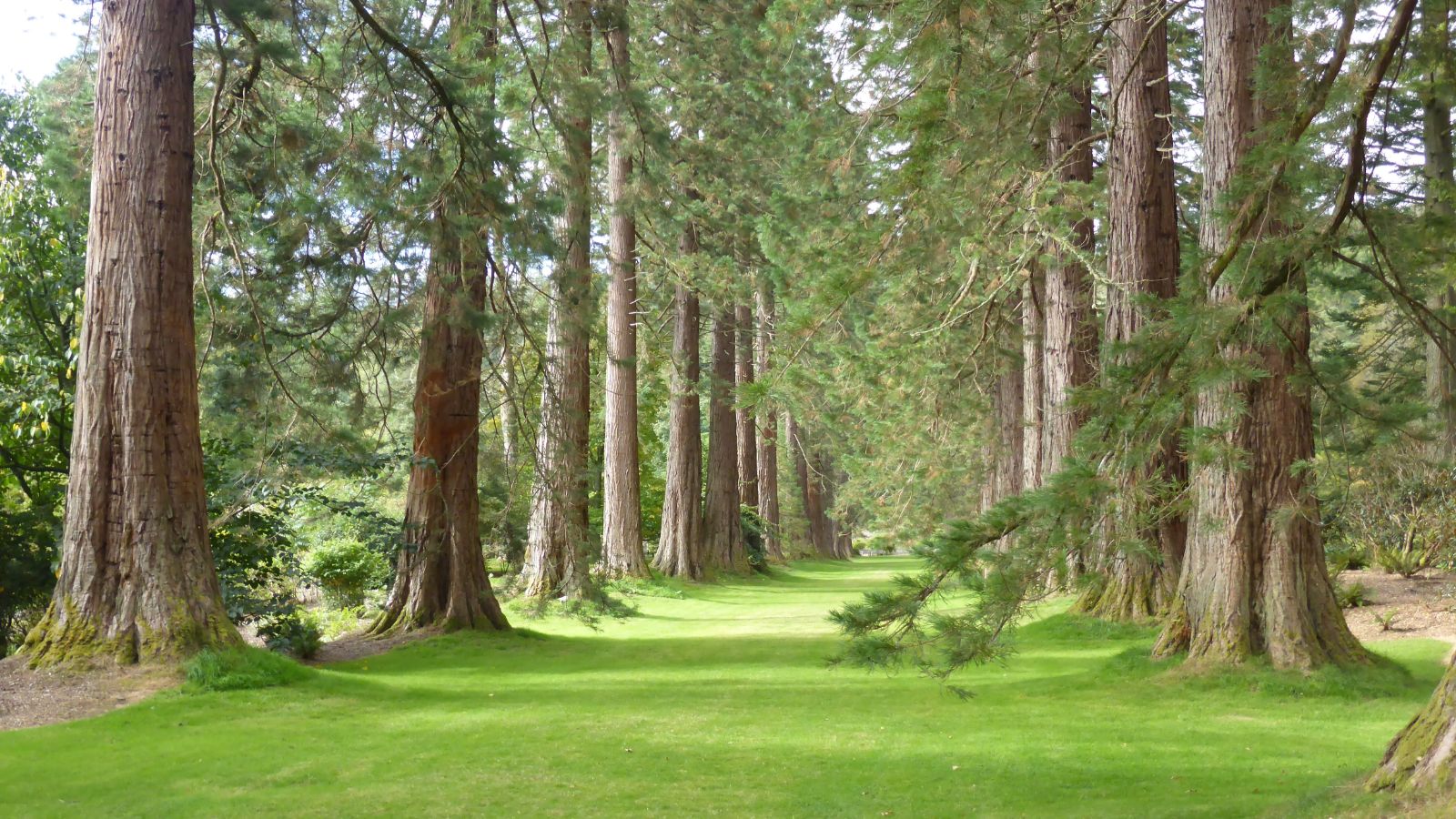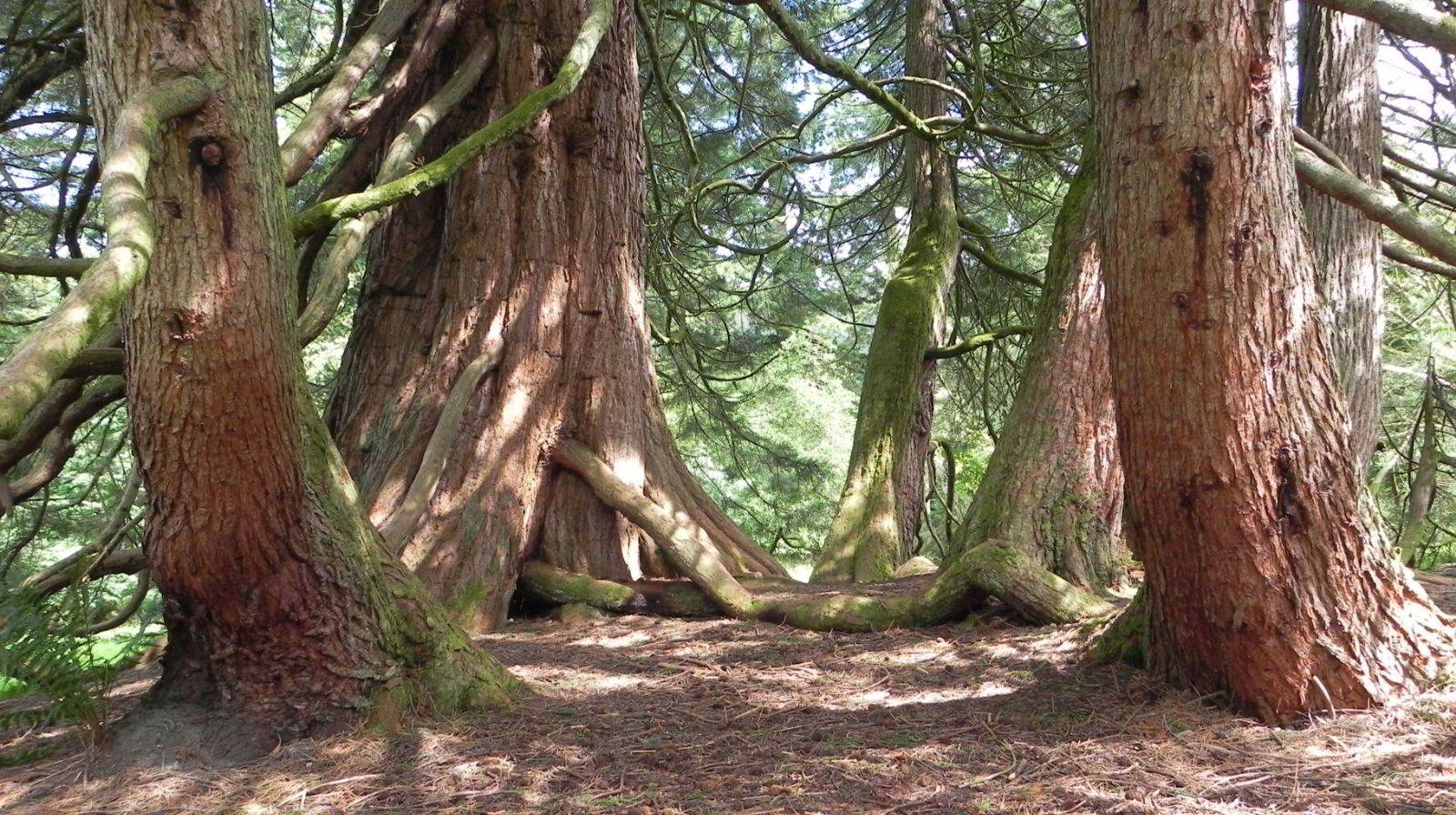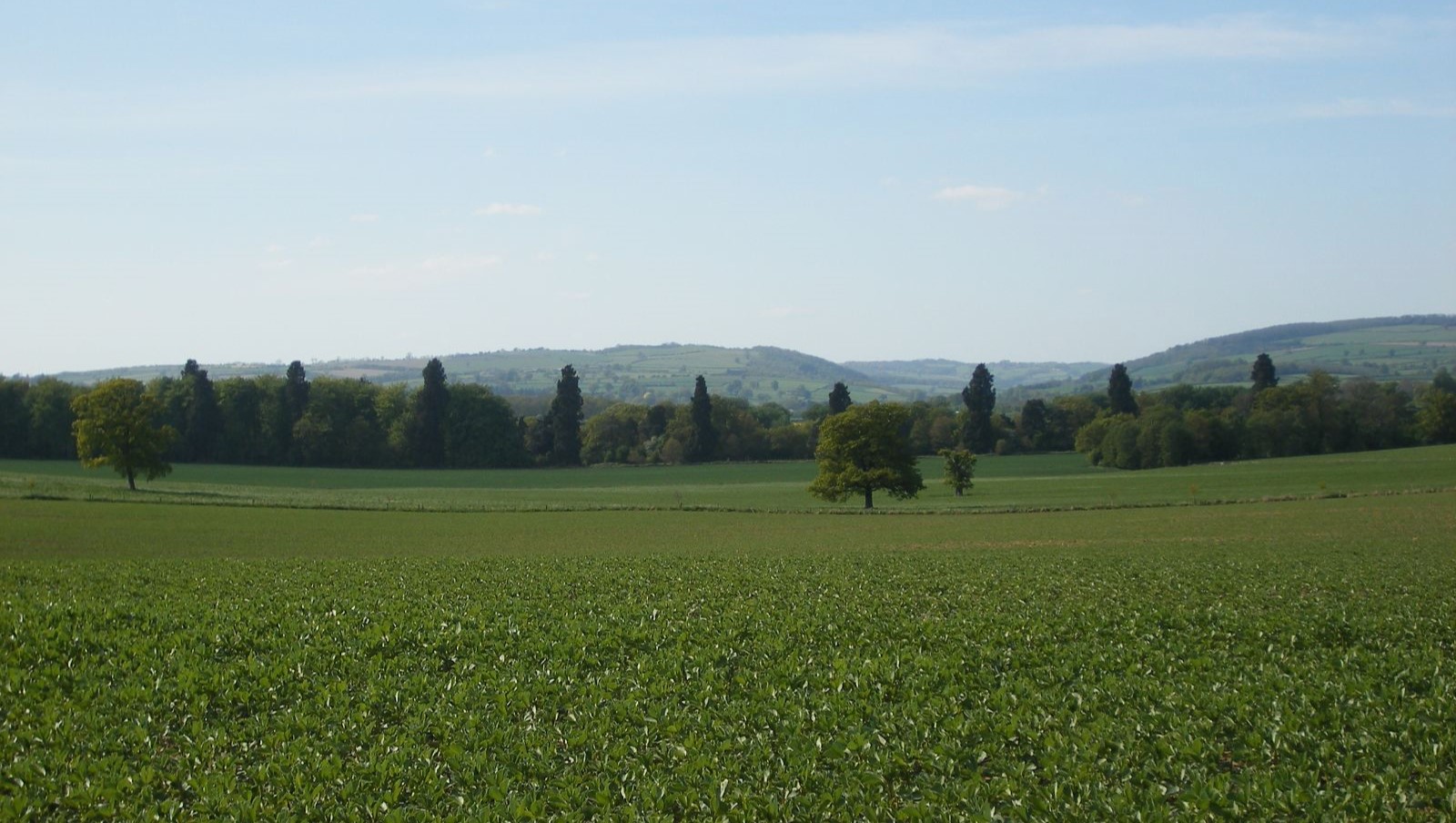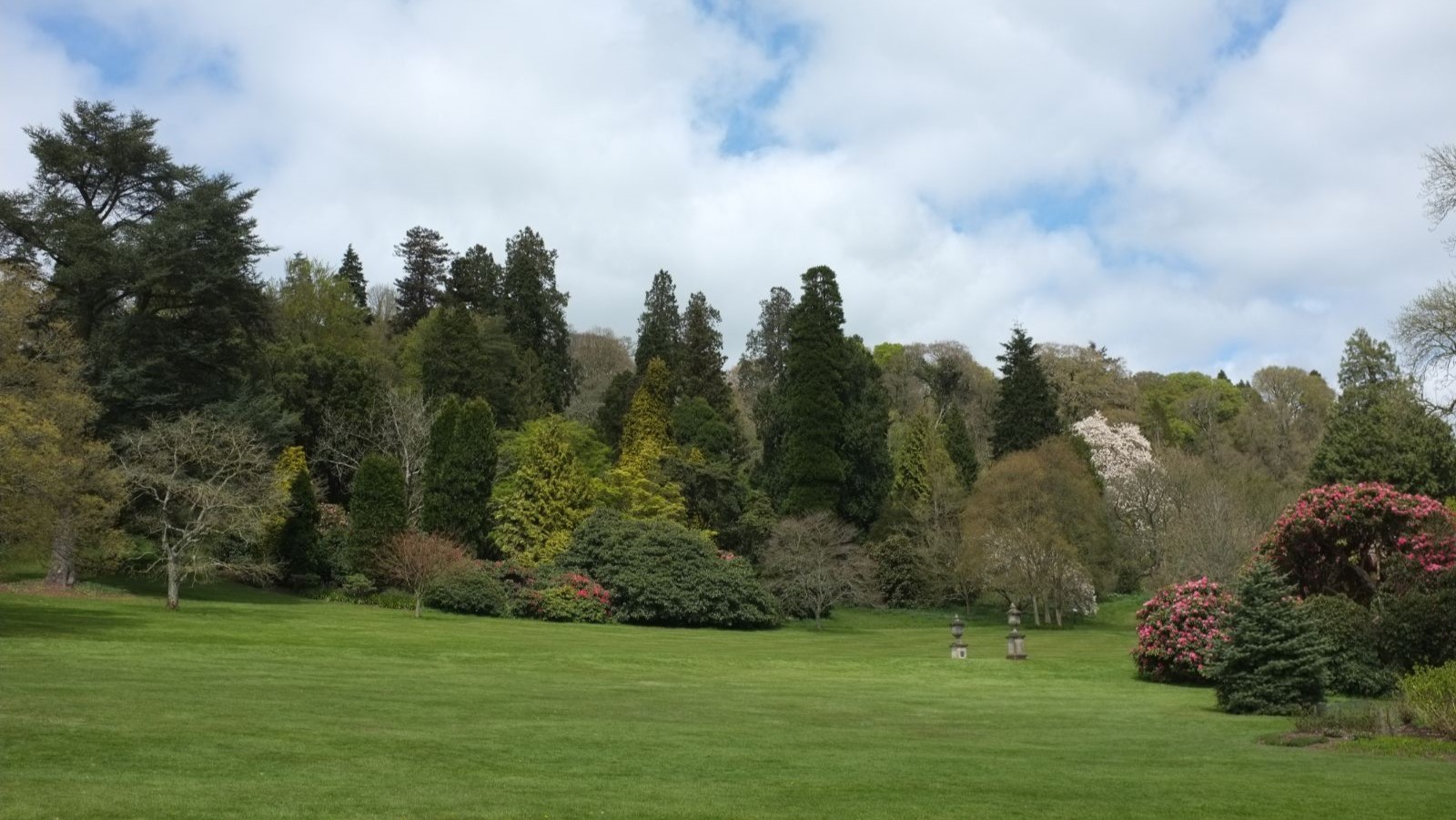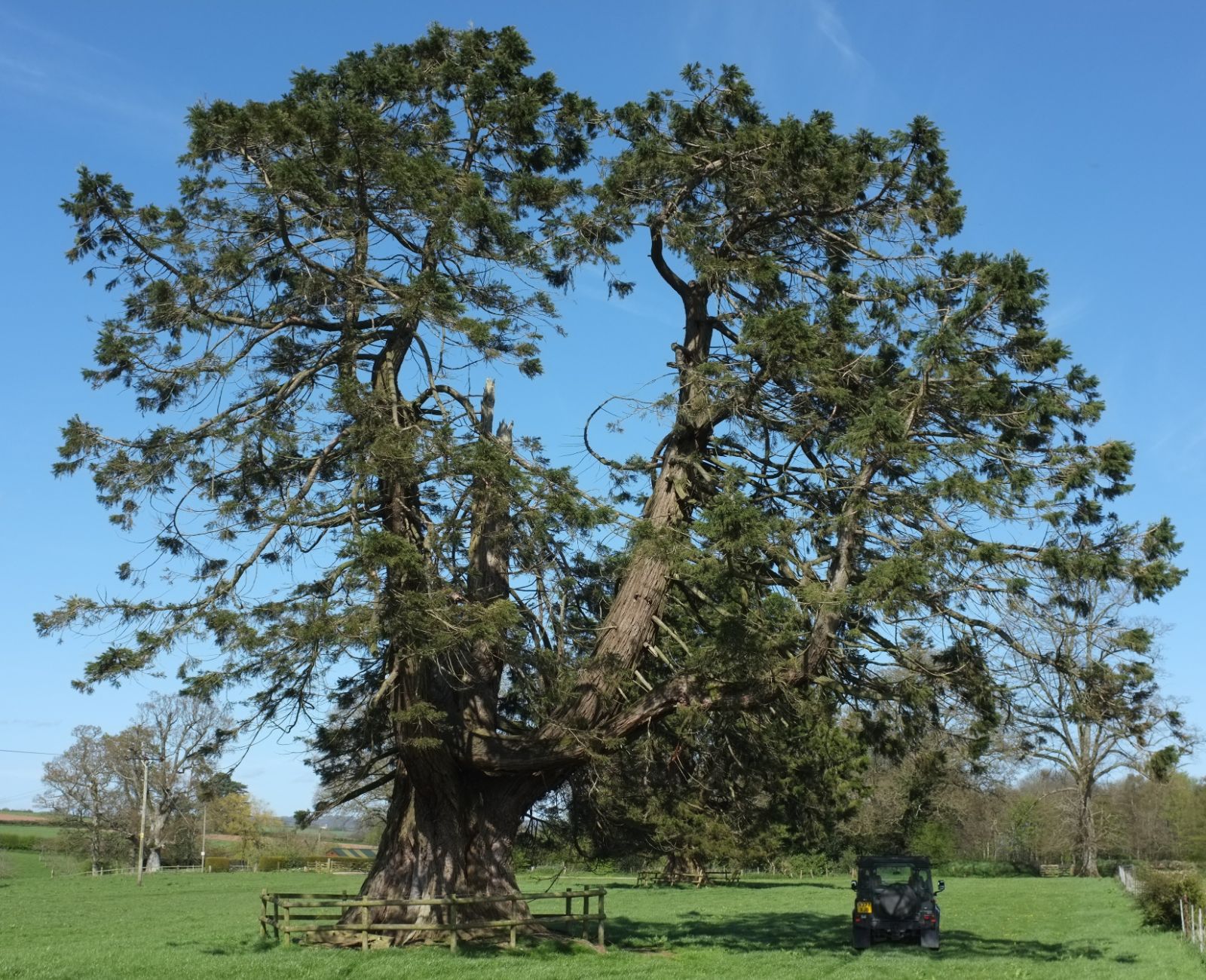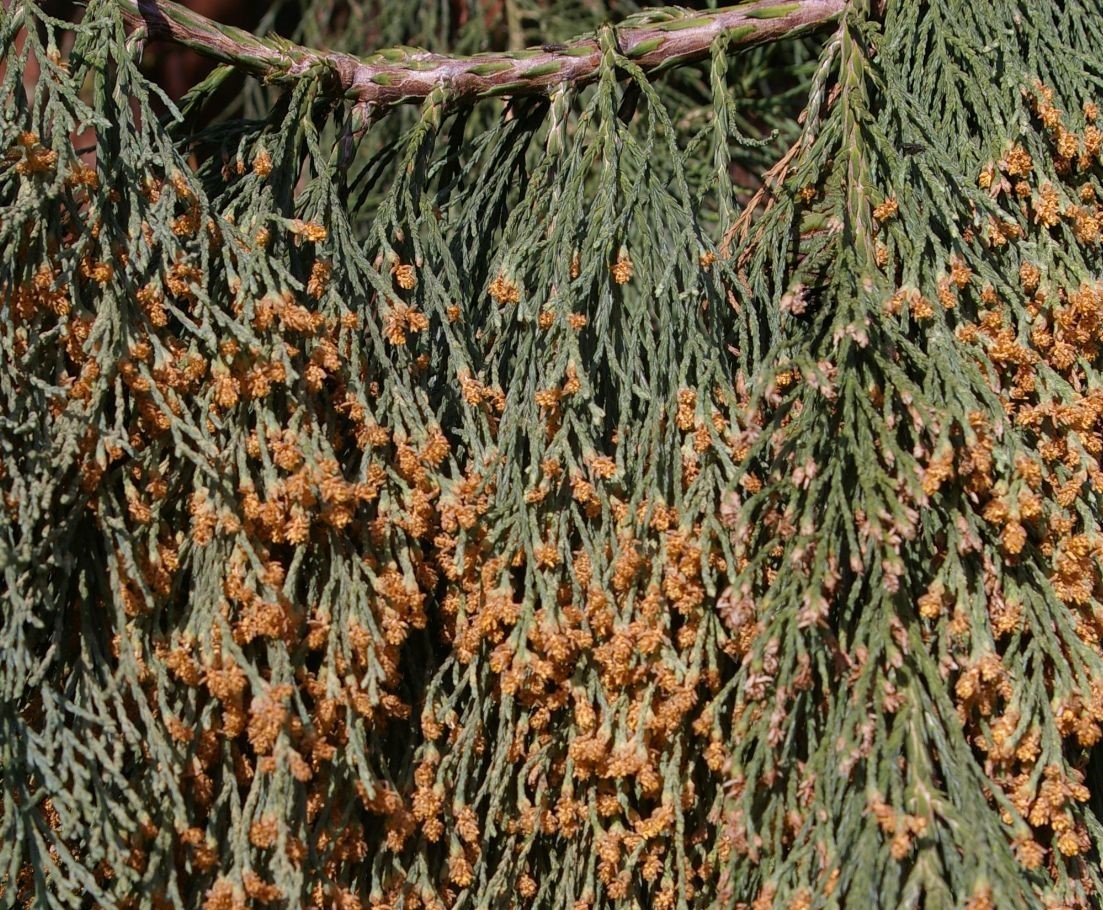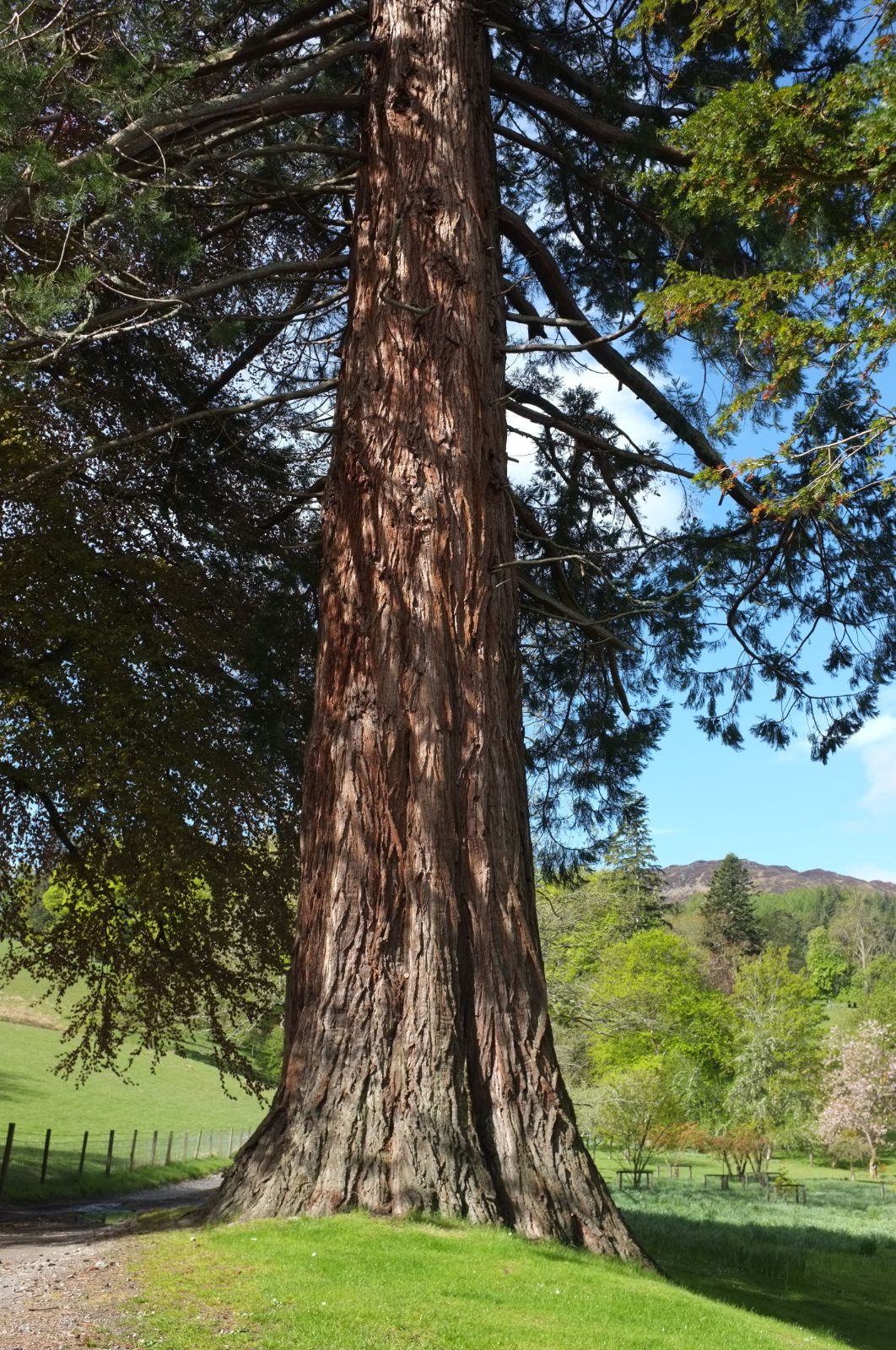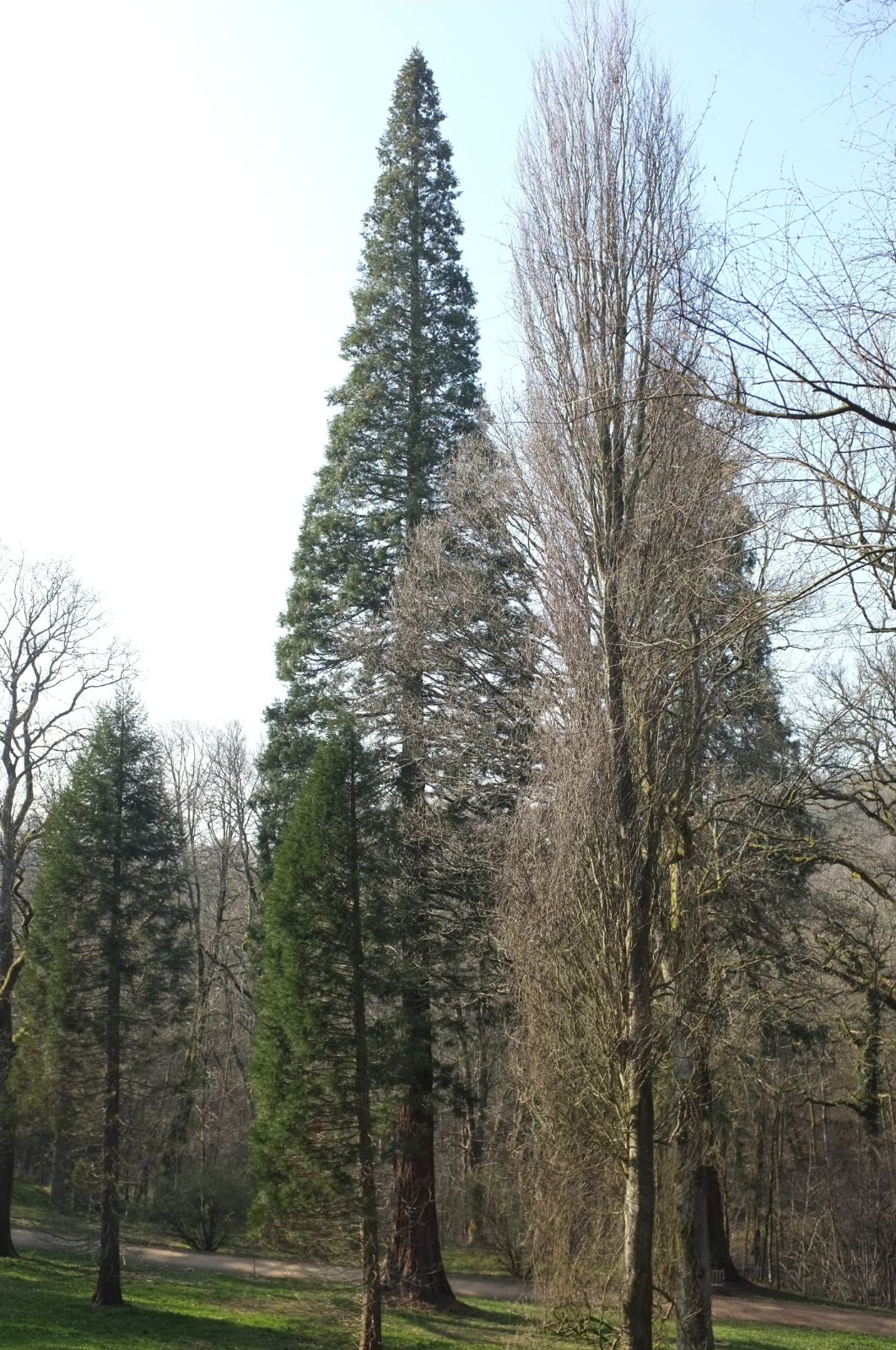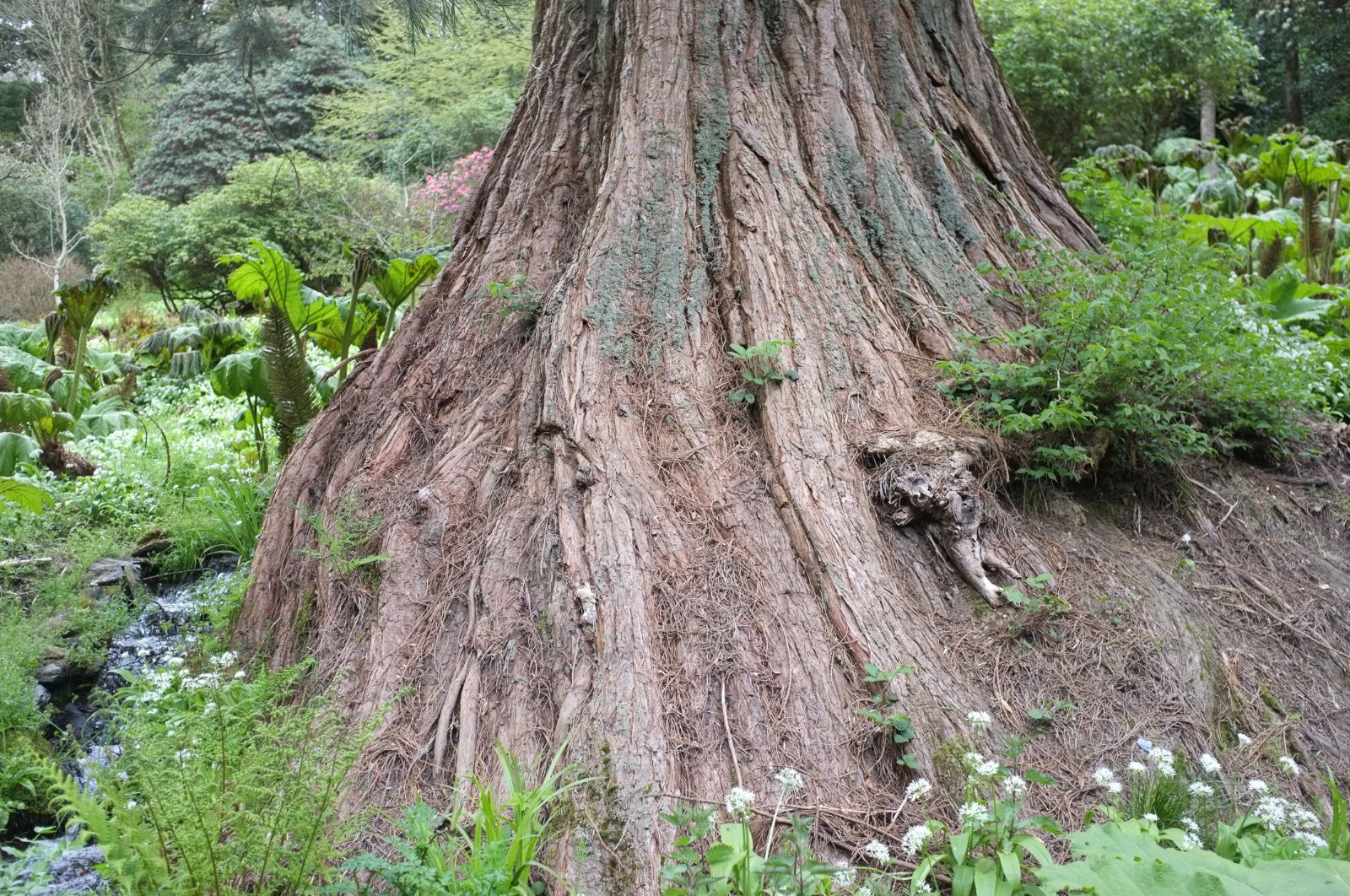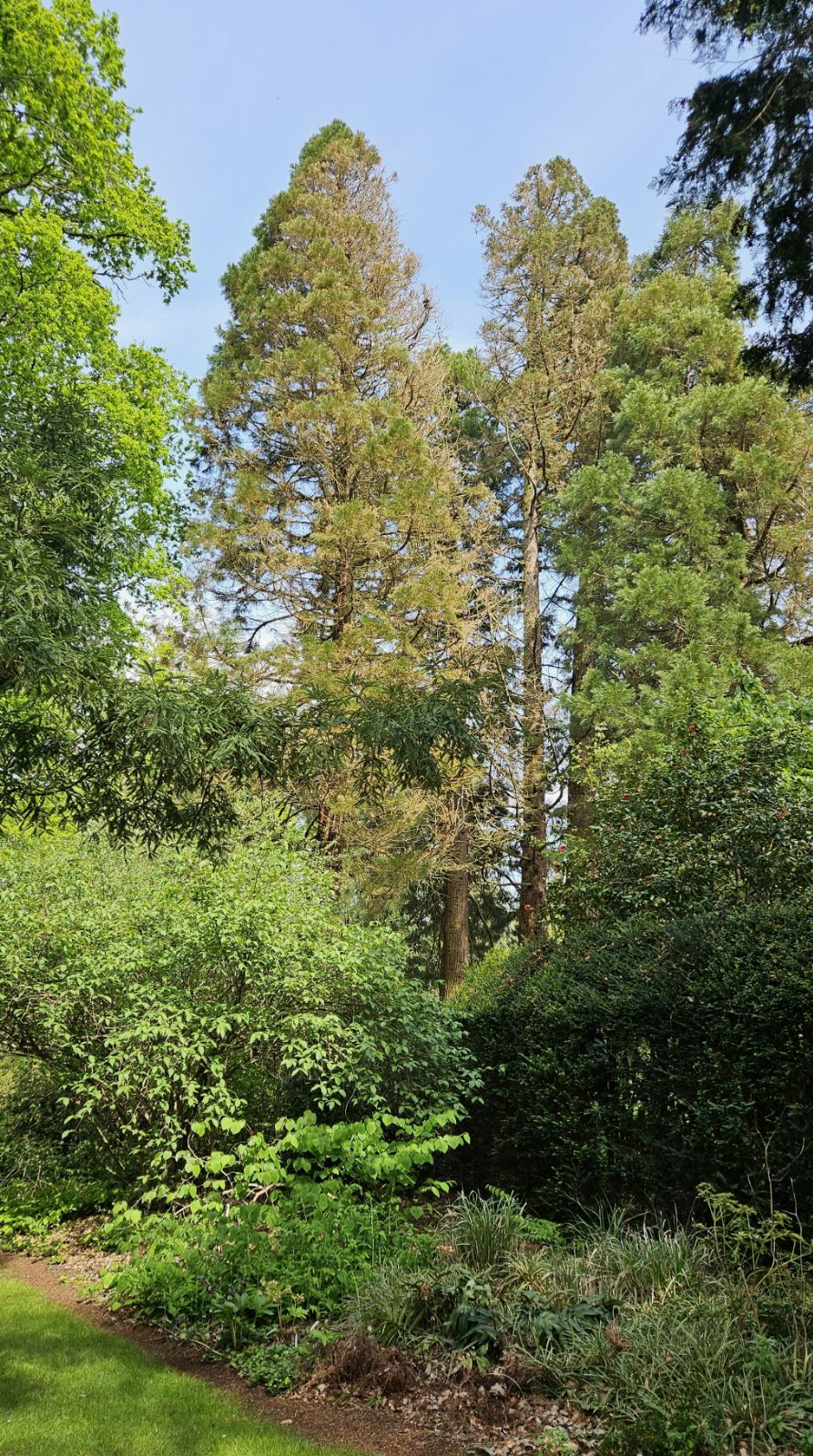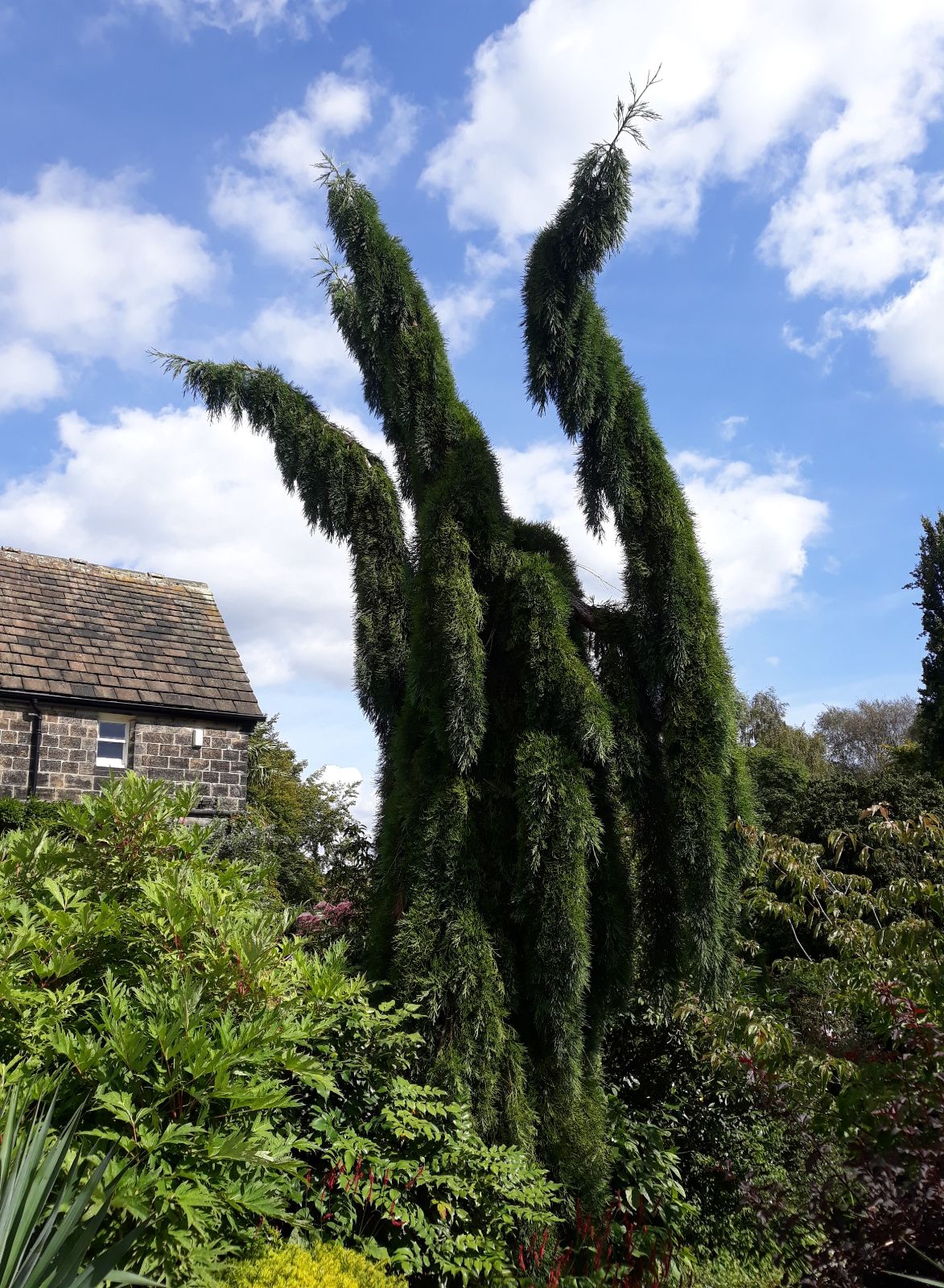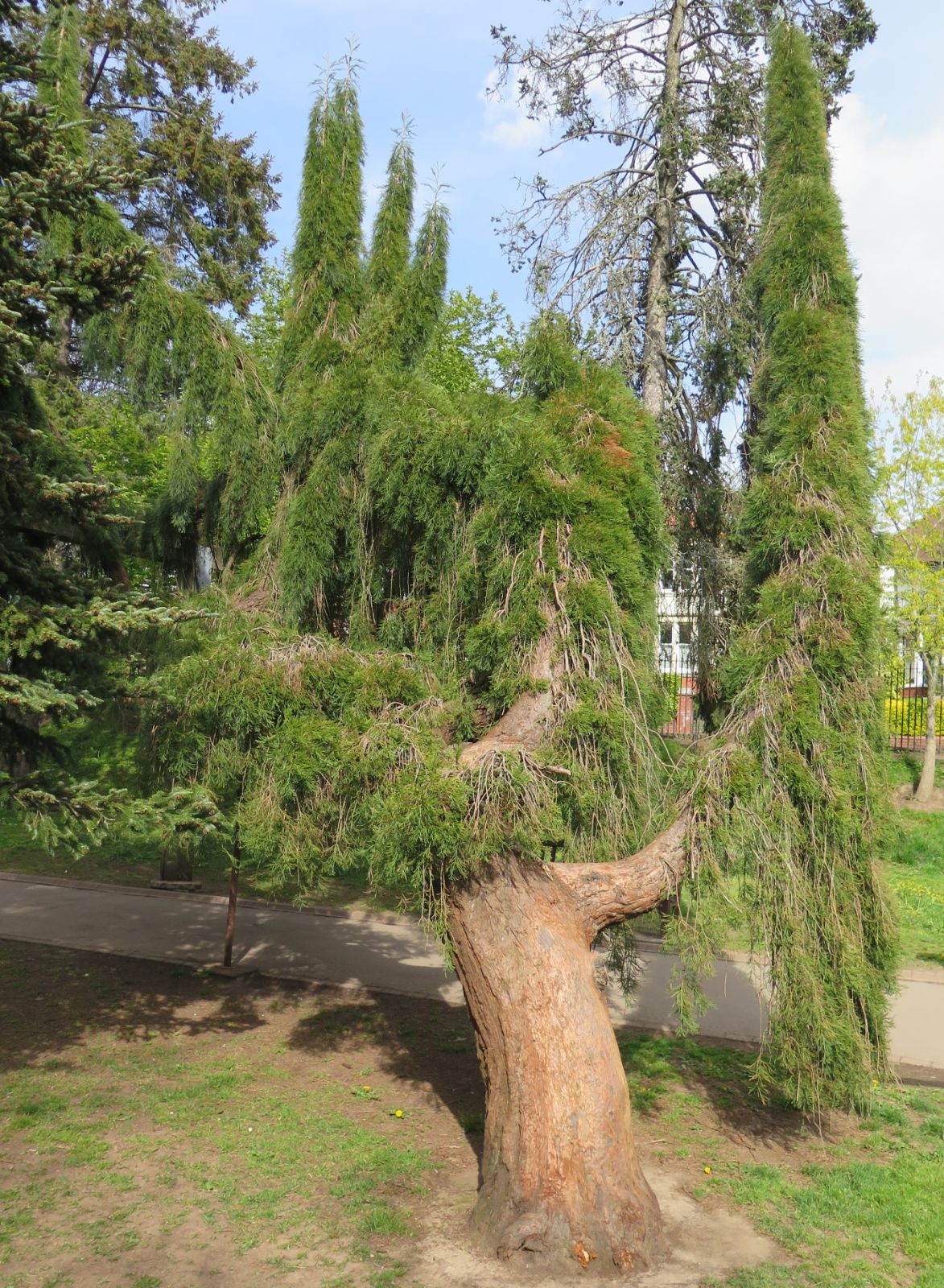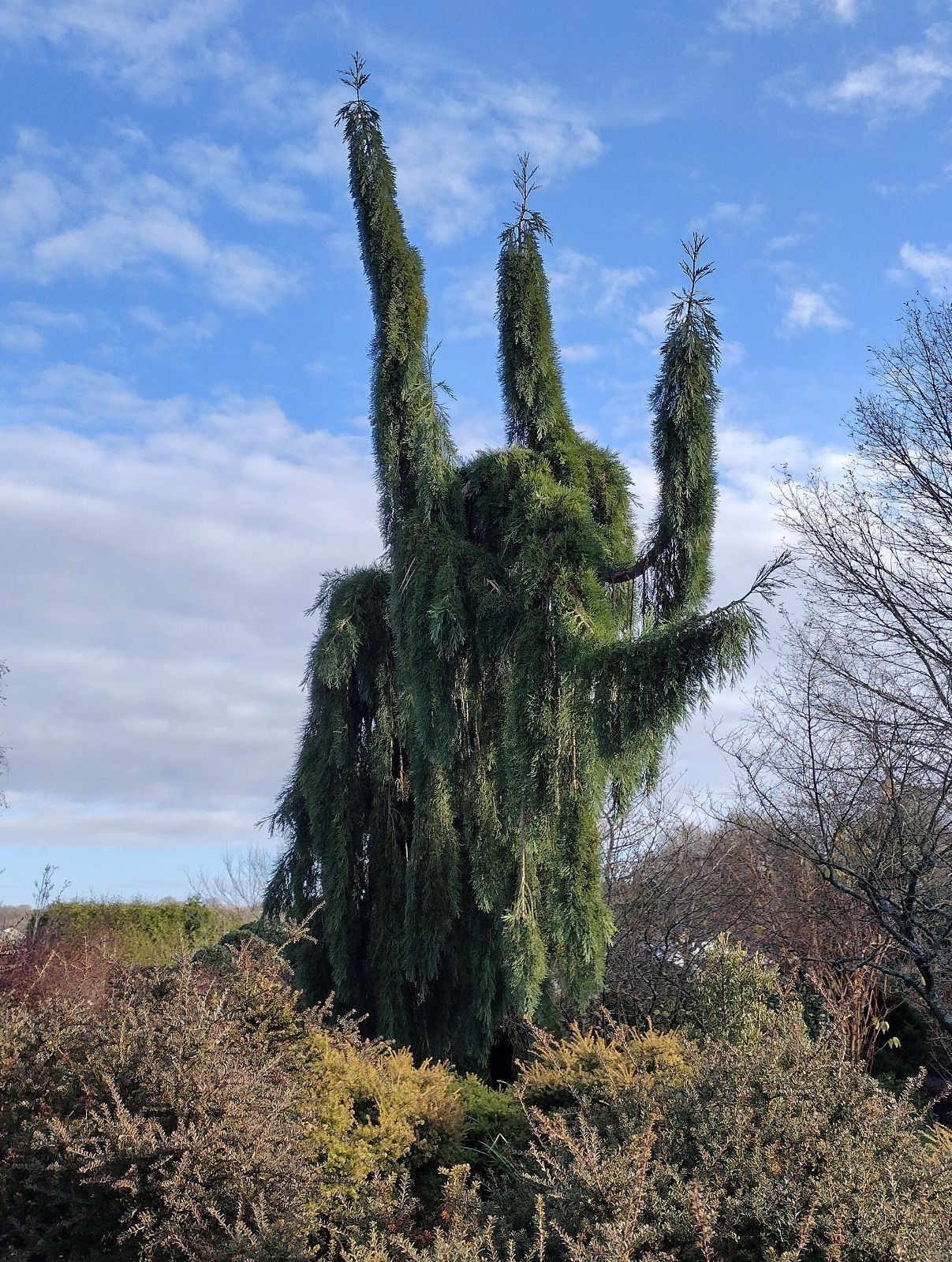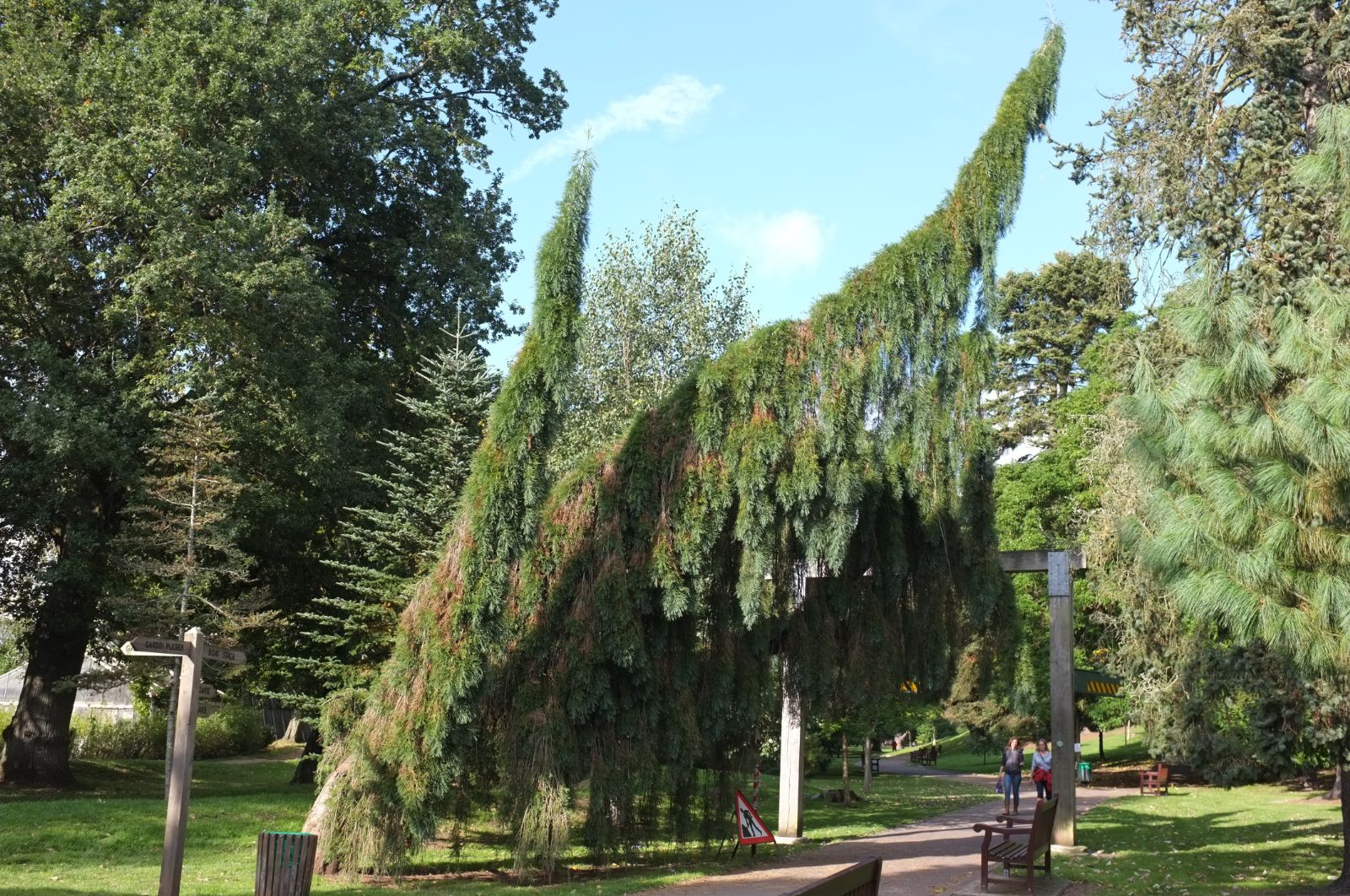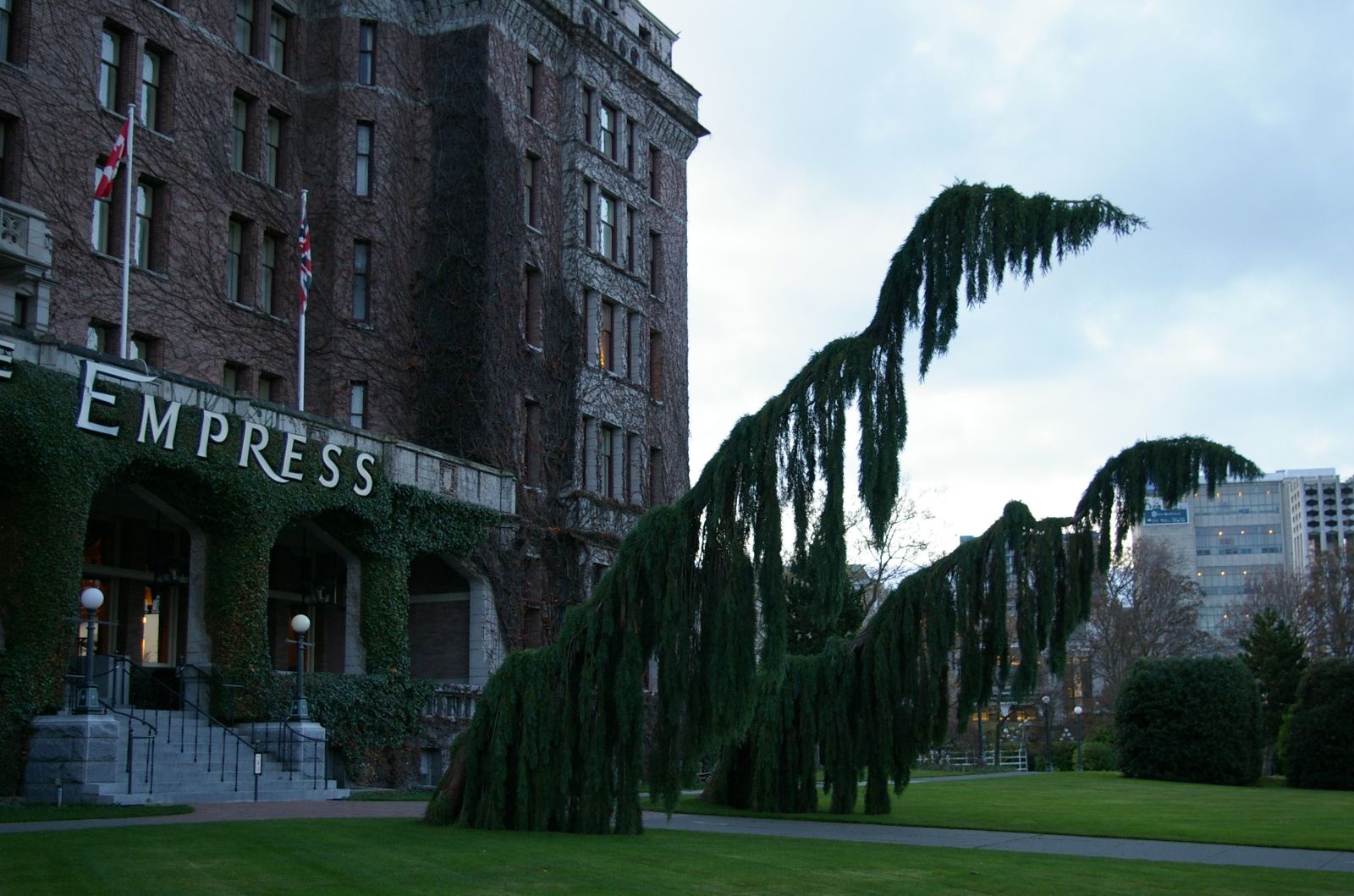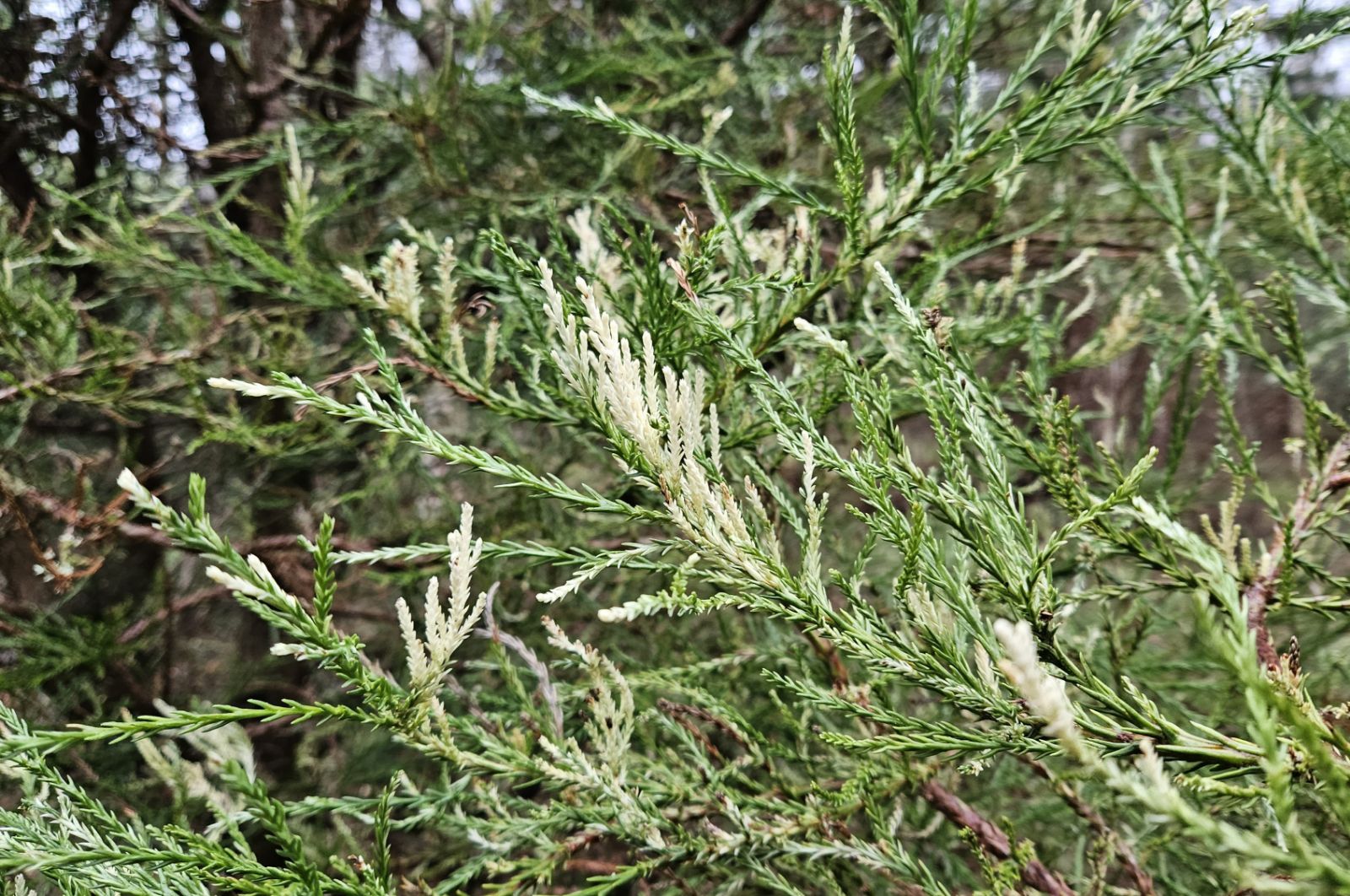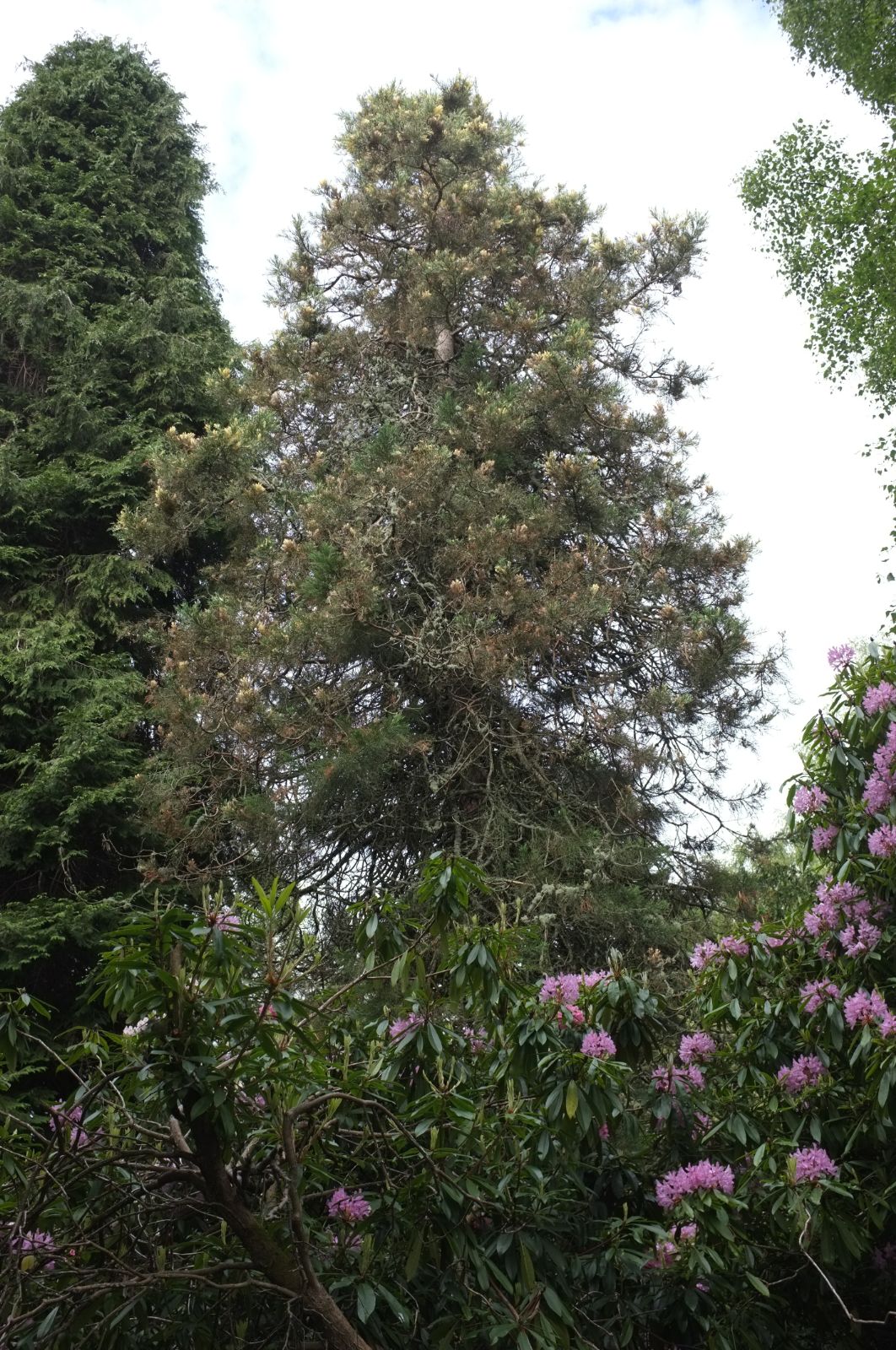Sequoiadendron giganteum
Sponsor
Kindly sponsored by
a member of the International Dendrology Society
Credits
Tom Christian (2024)
Recommended citation
Christian, T. (2024), 'Sequoiadendron giganteum' from the website Trees and Shrubs Online (treesandshrubsonline.
Genus
Common Names
- Big Tree
- Mammoth Tree
- Giant Redwood
- Giant Sequoia
- Sierra Redwood
- Wellingtonia
- Mammutbaum
- Mammoetboom
- Le Séquoia Géant
- Secoya de Sierra
- Sekvojovec Obrovský
Synonyms
- Americus gigantea (Lindl.) Hanford
- Gigantabies wellingtoniana (Seem.) J.Nelson nom. superfl.
- Sequoia gigantea (Lindl.) Decne. (1854) nom. illeg., not Endl. (1847)
- Sequoia washingtoniana Sudw. nom. superfl.
- Sequoia wellingtonia Seem.
- Steinhauera gigantea (Lindl.) Kuntze ex Voss
- Taxodium giganteum (Lindl.) Kellogg & Behr
- Taxodium washingtonianum C.Winslow nom. superfl.
- Washingtonia americana Gordon
- Washingtonia californica C.Winslow nom. superfl.
- Wellingtonia californica Sarg.
- Washingtonia gigantea (Lindl.) Carrière
- Wellingtonia gigantea Lindl.
Infraspecifics
- 'Albospicum'
- 'Album Spicum'
- 'Argenteovariegatum'
- 'Argenteum'
- 'Argenteum Spicatum'
- 'Aureocompactum'
- 'Aureovariegatum'
- 'Bajojeka'
- 'Barabits Requiem'
- 'Barronii Pendulum'
- 'Barts Green'
- 'Beautiful Jop'
- 'Blauer Eichzwerg'
- 'Bultinck Yellow'
- 'Cannibal'
- 'Carneval'
- 'Cassidy's Dwarf'
- 'Chief'
- 'Compactum'
- 'Conrad Appel'
- 'Cream Tower'
- 'Curly Green'
- 'Cylindricum'
- 'Desperado'
- 'Dolomore'
- 'Exceptionally Blue'
- 'Flavescens'
- 'French Beauty'
- 'Glaucum'
- 'Glaucum Compactum'
- 'Glaucum Nanum'
- 'Globosum'
- 'Globus'
- 'Golden Weeping'
- 'Greenpeace'
- 'Hazel Smith'
- 'Holmesii'
- 'Julian'
- 'Lacy Blue'
- 'Lighting Green'
- 'Little Stan'
- 'Lucie'
- 'Luzzi'
- 'Moonie's Mini'
- 'Müller'
- 'Nanum'
- 'Neuchatel'
- 'Pendulum'
- 'Pendulum Verum'
- 'Pete's Fastigiate'
- 'Peve Bonsai'
- 'Philip Curtis'
- 'Pierie'
- 'Pirat'
- 'Powder Blue'
- 'Pygmaeum'
- 'Pyramidale'
- 'Pyramidale Compactum'
- 'Pyramidale Glaucum'
- 'Shorty's Blue'
- 'Strictum'
- 'Variegatum'
- 'Viride'
- 'Von Martin'
- 'WB'
- 'Yellow Stone'
- 'Yreka'
Other taxa in genus
A massive, monoecious, evergreen, coniferous tree to 90–95 m tall, trunk monopodial, straight, the base often buttressed and flaring, becoming massive, to 8–10 m in diameter above buttress. Bark to 30–60 cm thick in the bole of old trees, cinnamon to reddish-brown, fibrous, soft, somewhat spongy, deeply fissured with age. First order branches assurgent to spreading, potentially massive, to 2–2.5 m in diameter in old growth trees, often with numerous reiterations, forming a very regular conical-pyramidal crown in young trees, later columnar, and latterly irregular and rounded to flat-topped; second order branches spreading or lax and drooping, branching irregularly alternate; final 3–4 branching orders covered with persistent green scale leaves, obscuring the shoot. Leaves spirally arranged in 3 ranks, imbricate, decurrent, very variable in size according to the age of the branch they are on, smallest on ultimate branches, bluntly keeled, margins entire, apex acute to apiculate, amphistomatic. Pollen cones terminal, on the same branches as seed cones, solitary, subglobose, 4–6 × 3–5 mm, with 15–20 microsporophylls each with 2–3 globose pollen sacs. Seed cones terminal on short branchlets, oblong to subglobose, 30–70(–95) × 25–50(–65) mm, maturing over two years, green at first, maturing brown, opening on the tree then later falling, but capable of remaining green and on the tree for many decades, releasing viable seed intermittently. Bract scales helically arranged, peltate, thickly woody, persistent, distal part rhomboid, 12–30 × 6–12 mm, proximal part narrowing to a pedicellate base. Seeds c. 200 per cone, oval, 5–7 × 3–5 mm including wings, flattened, greyish brown; wings 2, unequal, yellowish brown. Cotyledons (3–)4(–6). (Farjon 2017; Watson & Eckenwalder 1993; Earle 2024).
Distribution United States California; western foothills of the Sierra Nevada in c. 67 groves from near Lake Tahoe to California Hot Springs, the majority of groves south of the King's River in Fresno and Tulare Counties.
Habitat Mixed forests at 900–2700 m asl mostly on deep, fertile, moist but well drained alluvial soils often near watercourses. Availability of groundwater seems to be an important factor determining longevity. The climate is characterised by warm, dry summers and mild wet winters. Common associated conifers including Abies concolor, A. magnifica, Calocedrus decurrens, Pinus lambertiana, P. ponderosa, P. jeffreyi, Pseudotsuga menziesii and very locally Taxus brevifolia. Common broadleaf associates include Acer macrophyllum, Alnus rhombifolia, Cornus nuttallii, Quercus chrysolepis, Q. kelloggii and Salix scoulerana. Common components of the shrub layer include Castanopsis sempervirens, Ceanothus spp. and Arctostaphylos patula.
USDA Hardiness Zone 7
RHS Hardiness Rating H6
Conservation status Endangered (EN)
Like its close relative and near namesake Sequoia sempervirens, Sequoiadendron giganteum is one of the great wonders of the world. Both trees have been so extensively considered, investigated and written about, in the popular and scientific press alike, often with entire volumes dedicated to them, that there is a real risk of any new discussion simply reinventing the wheel. As such, for Trees and Shrubs Online we aim to provide an overview of their natural and horticultural histories, and at appropriate points throughout both articles direct readers to suggested further reading.
The principle reason for both trees’ celebrity is their sheer size, while great longevity adds to their allure. Sequoia, the Coast Redwood or to some simply the Redwood, currently holds the title of the world’s tallest tree and examples are known to be over 2200 years old, while Sequoiadendron, the Sierra or Giant Redwood or Giant Sequoia or Wellingtonia or Big or Mammoth Tree, is generally considered the world’s largest by girth or volume and stumps have been dated to over 3200 years (Debreczy & Rácz 2011; Earle 2024). Old growth stands of both species are an astonishing sight, and a visit to these can be a deeply moving experience whatever one’s interest – or disinterest – in the natural world.
Sequoia, growing near the California coast, must have been known to explorers and settlers for many hundreds of years, but Sequoiadendron, ensconced in the western foothills of the Sierra Nevada, would not come to prominence until the early 1850s. Ever since, countless travellers have attempted to put into words what it is to walk among these trees. Even allowing for how personal such an experience is, few have succeeded, and the early impressions of the famous naturalist John Muir have perhaps stood the test of time better than those of many who have followed in his footsteps. One senses from his writing that to step into these forests is to step into another world. As the 21st century advances new generations of visitors might qualify this sentiment; that to walk in these forests is to walk in a world that is disappearing, for the threat they are now facing is arguably far graver than any they have faced before.
In the late 19th century, when armies of loggers were putting the axe to entire forests of Sequoia and Sequoiadendron, this very tangible threat to their continued existence gave rise not only to America’s first National Parks but also the modern conservation movement (Earle 2024). Over a century later, the threats posed by climate change remain too remote or seemingly existential to far too many, especially in the most polluting nations, to generate the forcefulness of public opinion or political will that is needed to bring about sustained behavioural change, and so with each passing year we witness more extraordinary events, such as wrapping the bases of the largest Sequoiadendron in fire retardant blankets to protect them from encroaching forest fires, which are burning with a frequency, ferocity and on a scale that has no recorded precedent (Robbins 2023).
Fire has always been an important part of Sequoiadendron ecology. The interaction between the tree, its wider habitat and fire has been long studied, although much remains to be understood (Earle 2024). Certainly, fire has been shown to be an important factor in seedling recruitment (e.g. Mayer & Safford 2011) and most of the extant stands are thought to have developed in response to fire cycles which first create expansive clearings with large canopy gaps and almost no understorey; these fires leave behind them a bed of fertile ash for seed to germinate in (like most Cupressaceae Sequoiadendron is a light-demanding early successional species, although Sequoia is quite different; this will germinate under canopy, grow in the shade and even regenerate from old stumps – Barbour et al. 2001). Sequoiadendron colonised these clearings along with a host of associates including Incense-cedars (Calocedrus decurrens), pines and firs, which grew together until the next fire (a period of a few years to a few decades) would significantly reduce the proportion of thin-barked, fire-susceptible pines and firs, while Sequoiadendron, with their thick, fibrous, bark, were better able to withstand the fire and would survive and go on to dominate the grove, with the competition kept in check by occasional fires (Mayer & Safford 2011; Parsons & DeBenedetti 1979).
However, a well-intended but catastrophic policy of fire suppression throughout much of North America during the early 20th century meant that without prompt action small unplanned fires could quickly become infernos, laying waste to thousands of acres at a time as the accumulation of debris in the forest acted as tinder, significantly increasing a fire’s intensity. Recovery from such unnaturally large and intense fires takes much longer than recovery from smaller, faster-moving ones, besides which, in areas that remained unnaturally fire-free, the vegetation structure and age composition of the forest was affected in such a way as to increase vulnerability (Parsons & DeBenedetti 1979). In many areas, including reserves home to extant groves of Sequoiadendron, authorities now practice regular, carefully controlled burns to prevent the build-up of combustible debris on the forest floor and also to realise the wider ecosystem benefits that small fires can bring. An investigation following the Washburn fire, which affected parts of the Mariposa Grove in Yosemite National Park in July 2022, and which received extensive publicity due to the significant threat it posed to Mariposa’s Sequoiadendron, found that Yosemite’s fire management practices, including a policy of so-called prescribed burning dating back to the 1970s, was a significant factor in helping the authorities to bring the Washburn fire under control and minimise damage (Hankin et al. 2023). Such management regimes are set to become increasingly important, as there is evidence that the rapid increase in the frequency of severe fires is having a detrimental impact on Sequoiadendron’s resilience to fire, particularly in the largest and oldest trees (Shive et al. 2022).
Quite how many groves of Sequoiadendron exist in the western foothills of the Sierra Nevada depends on how one counts them; a list published by the Yosemite Association in 2000 gives 67 and this figure is generally accepted – it is used, for example, in the species’ IUCN conservation assessment (Thomas, Schmid & Farjon 2019). ‘Grove’ is an unusual means of describing wild populations of any tree, but it is widely used in the case of Sequoiadendron because the extant stands are very well defined and cover relatively small areas (Earle 2024). Most groves occur in the southern part of the distribution, in Sequoia & Kings Canyon National Parks and nearby in Fresno and Tulare counties (Debreczy & Rácz 2011). From the southernmost grove near California Hot Springs, north to the Converse and Indian Basin Groves near King’s Canyon, 59 groves are scattered over a north-south distance of c. 111 km, with barely 5 km separating one grove from another. These southern groves contain the very largest trees, including the famous ‘generals’ such as the General Sherman tree. Beyond King’s Canyon, another eight groves are widely scattered over another c. 273 km, in the vicinity of Yosemite valley, Calaveras, and one remarkable grove some 30 km west of Lake Tahoe; this, the northernmost grove, is more isolated than any other and contains only six mature trees (Earle 2024). This nearly-400 km long north-south distribution extends only 25 km east-west at its widest point, with the combined area of all the extant groves totalling just c. 14,200 ha (142 km²) (Thomas, Schmid & Farjon 2019). It is impossible to guess how many trees were lost to logging in the 19th century, but there is no evidence that the species ever occured beyond the restricted locations it is known to occur in even before logging began; whilst the number of mature individuals was severely depleted, this did not necessarily reduce the total area of occupancy (Thomas, Schmid & Farjon 2019; Earle 2024).
Discovery and introduction to horticulture
The native American peoples of the Sierra Nevada, known today as Miwok and Western Mono were largely unaffected by the Spanish and Mexican dominion of California. That changed after the arrival of Americans of (broader) European descent, however, and particularly during the gold rush when they were marginalised and persecuted, their lands taken and their cultures dismissed, so that little is known of their interactions with the Big Trees among which they passed their summers.
Former national park ranger-naturalist William C. Tweed laments this loss of knowledge that forces him to begin his otherwise authoritative King Sequoia – a particularly digestible account of Sequoiadendron’s modern history – in the mid 19th century rather than several hundred years earlier (Tweed 2016) and in which he notes that, despite the relative density of the groves south of the King’s River, these were not the first Giant Redwoods to be discovered by Euro-Americans. Rather, it was the somewhat isolated population at Calaveras, some 50 km south of the southern shore of Lake Tahoe.
Few interested in the botany or horticulture of Sequoiadendron will know the names Zenas Leonard or Augustus T. Dowd, but it was Leonard, a trapper-explorer, who was one of the first Euro-Americans to look upon the giant trees after the hunting party he was with – led by Joseph Walker – stumbled upon a grove in 1833. Although it is still debated exactly which grove the Walker party encountered the weight of evidence points to the north grove at Calaveras (Tweed 2016). Leonard published an account of his adventures in 1839, including mention of giant trees, but it received little attention and it was not until early 1852 or 53 when the hunter Dowd wandered into the Calaveras north grove (whilst hot on the heels of an injured grizzly bear), that things began to happen.
Dowd had a reputation as a storyteller; indeed, it took him some effort to convince his colleagues that he wasn’t spinning yet another yarn, but they would see the trees for themselves and the Big Trees of Calaveras soon began to attract wider attention, with stories about them appearing in the popular California press by the end of May 1853. Dowd dispatched specimens to the newly formed California Academy of Sciences in San Francisco where they were received by the botanist Albert Kellogg, himself recently arrived in California (Tweed 2016).
Kellogg was apparently a cautious man for he did not immediately name the new species, preferring to wait until he had consulted with fellow scientists. In the meantime he showed the specimens to other interested parties, including the English plant collector William Lobb who had been travelling in the Americas since 1840, collecting plants on behalf of the Veitch & Sons nursery firm in Britain. Sensing an opportunity, Lobb apparently dropped everything and travelled to Calaveras ‘via overnight steamboat and a thirty-six-hour stage ride’ (Tweed 2016) to collect seed and specimens for his employers. He returned promptly to San Francisco and thence embarked on a steamship for home, landing in Britain by mid-December 1853. On his return, Lobb’s employer sent some of his samples to botanist John Lindley who quickly described the material as a new genus. His new generic name Wellingtonia, commemorating the recently deceased British politician and military hero, was published in the Gardeners’ Chronicle on Christmas Eve (1853, p. 823).
Even by the standards of the time this was an arrogant move by Lindley and it infuriated Americans that the greatest tree in the world – their tree – should have been named after a Brit; Kellogg countered, eventually, by proposing the name Washingtonia after the great American hero and a ‘furious and highly nationalistic pathos’ ensued (Farjon 2017) but in the end both names would be rejected (Wellingtonia has however remained a common vernacular name in the United Kingdom). Indeed, the question of the generic name was only eventually settled in 1939 when the (thankfully) American botanist John T. Bucholz published Sequoiadendron. Lindley’s Wellingtonia had already been used for a member of the Sabiaceae, and by the time Kellogg got around to publishing anything there was already an unhelpful slew of alternatives in circulation, as botanists debated how best to classify the new discovery. Thankfully the rules of botanical nomenclature gradually began to bring some order and method to the chaos, and the name Sequoia gigantea became the accepted name for much of the period from the late 1850s to 1939, until the distinctiveness of Giant Redwood was finally proven to merit treatment in its own genus. At the time, many botanists balked at the publication of Sequoiadendron, but it gradually became widely accepted (Earle 2024); a small minority of botanists have continued to countenance its inclusion in Sequoia (e.g. Watson & Eckenwalder (1993)) but the legitimacy of Sequoiadendron has never been seriously challenged.
Meanwhile Lobb, together with his employer and probably Lindley too, could all have been forgiven for thinking that his was the first introduction of the new tree to Britain, but this was not the case. Among the many who travelled to join the California gold rush in the early 1850s was a Scottish surveyor, mining engineer and amateur botanist named John D. Matthew, son of Patrick Matthew, a wealthy Scottish merchant and landowner who lived in the Carse of Gowrie in Perthshire, between the cities of Perth and Dundee. Matthew set about procuring seed of this arboreal wonder for his father, who had a great interest in natural history, and made the journey to Calaveras at the beginning of July 1853, a month or so before Lobb, and immediately sent seed home which arrived in Perthshire a few weeks later, thus securing the honour of being the first person to introduce the new tree to Britain (Ravenscroft 1884, vol. 3). Patrick Matthew raised many young trees from his son’s consignment and planted them on his estate and gifted many more to friends and neighbours, while Lobb’s enormous haul would ensure Veitch & Sons a monopoly on its commercial supply through much of the remainder of the decade (Shepard 2003; Bean 1981).
Besides satisfying domestic demand, Veitch also dispatched material to more temperate parts of the British empire, notably Australia and New Zealand, as well as to many neighbouring European nations. European nurseries would soon secure their own, independent supplies, for example when M. Boursier de la Rivière sent seed to France from California in 1854 (Ravenscroft 1884, vol. 3) and Californian nurseries were soon in on the act, too; Sequoiadendron was being sold in the state certainly by 1858 and probably earlier (Jacobson 1996). Within a few years regular seed consignments ensured a supply to most horticulturally minded European nations and even in Britain Veitch’s monopoly would soon weaken. By 1884, Edward Ravenscroft was able to observe in his Pinetum Britannicum that the plant ‘is no longer rare or high priced’ (Ravenscroft 1884, vol. 3) and much as is the case with Monkey Puzzle (Araucaria araucana) in the UK and Ireland today, an extant tree’s status as a ‘Lobb original’ should not be taken on hearsay, although a far greater number of Lobb Sequoiadendron surely survive than Lobb Araucaria.
It has long been a source of frustration that the various trees raised and distributed by Patrick Matthew were not better documented. When Matthew received seed in August 1853 he divided it and sent shares to at least two friends, who raised their own seedlings and distributed the excess of their own efforts in turn. Ravenscroft (1884, vol. 3) was only able to track down eleven trees from this introduction with certainty, whereas Bean later considered that ‘From this sending most of the oldest trees in Scotland probably derive’ (Bean 1981). In reality, and in the absence of documentary evidence, it is impossible to say, at least of the oldest trees in Scotland, whether a tree might have come from Matthew or Lobb seed. Lobb’s much larger gathering was only four months behind, and by the following spring – when Veitch announced the availability of Lobb seedlings for summer dispatch – interest was at feverpitch, and the sheer size of Lobb’s introduction ensured supply was able to keep pace with ravenous demand (and caused this material to be credited persistently as ‘the first introduction’). The Scottish landowners lucky enough to have received a Matthew plant would have supplemented it with Lobb material at the earliest opportunity and after a few years such nuanced details as to ‘whence our trees’ would often be forgotten. Indeed, the contribution of the Matthew family to Britain’s Giant Redwood story went largely unacknowledged, and was only brought to the attention of the wider British horticultural community in an article in the Gardeners’ Chronicle of 15 December 1866. Detective work has occasionally turned up the odd original Matthew tree that Ravenscroft failed to identify, perhaps having been raised from one of the seed batches Matthew sent to trusted friends. A superb tree at Castle Leod, Strathpeffer, Scotland, was according to estate records received in 1853 and can therefore only have come from the Matthew introduction; it is now one of the finest examples in Britain and probably the largest tree at its latitude in the world (Rodger, Stokes & Ogilvie 2006).
It has been stated that Veitch continued to send out Lobb Sequoiadendron as late as 1860; this is perfectly plausible, but it brushes over the fact that subsequent seed introductions followed Lobb’s, albeit modestly at first, and later in greater quantity, from the 1850s right up to the present day. Particularly in the context of the early plantings of the 1850s and early 1860s this makes it virtually impossible, again in the absence of documentary evidence, to say whether or not a plant is from Lobb’s gathering. As other nurseries got in on the act Veitch’s market share reduced, but this was not necessarily a cause for concern, for Sequoiadendron had already produced golden cones for Veitch. In the middle of the 19th century newness was an irresistible lure for gardeners; coupled with Sequoiadendron’s status as probably the largest living thing on the planet and a wonder of the world, the tree became irresistible, the must-have item of 1854 and for several years after that: in Britain its association with the Duke of Wellington further boosted that popularity. When Veitch first offered young seedlings for sale in spring 1854 over 3000 are said to have been sold in a single day, with the largest fetching two guineas each (c. £200 in modern money) (Tweed 2016). Jacobson does not exaggerate when he says that Giant Redwood was ‘grown wherever possible’ (Jacobson 1996): the British upper middle class planted single specimens on the lawns of their suburban villas; aristocrats and wealthy industrialists peppered the grounds of their country estates with them; incurable show-offs planted avenues comprising many dozens of trees; while others were sequestered in all manner of locations, in vicarage gardens and churchyards, on hilltops and village greens, in quiet corners of woods and in the grounds of remote shooting lodges. One recent study identified just under 5000 ‘notable’ individual Sequoiadendron growing in the UK (which in this context can be taken to mean that the majority of these trees are mature) based on several data sources (Holland et al. 2024). It seems reasonable to assume that another several thousand will be unrecorded, but claims that up to half a million individuals grow in the UK should be interpreted cautiously. This figure seems to have arisen from a Forestry England estimate for the number of Sequoiadendron giganteum and Sequoia sempervirens growing in the UK, and would additionally appear to include planting figures from recent afforestation initiatives, not just mature individuals (forestryengland.uk).
Nevertheless, the clearly significant cultivated population of Sequoiadendron, especially in the UK and Ireland, has been cited an example of the potential value of garden plants to biodiversity conservation, but caution is advised. The thousands, perhaps tens of thousands of Sequoiadendron in cultivation clearly represent genotypes that do not exist in the wild, but it is important to remember that the first introductions all come from the same location, Calaveras. Recent research has indicated that the northern groves, which include this location, should be a conservation priority given their more fragmented distribution compared to groves south of the Kings Canyon (DeSilva & Dodd 2016) but it is important to note that within a few years of Calaveras’s discovery other groves would be found to the south, and later introductions would probably have sampled these, but there are remarkably few introductions other than the original Matthew and Lobb collections from Calaveras, and a startlingly small number of more recent collections resulting in a very small numbers of plants usually restricted to botanic gardens, that can claim known provenance. The near-total absence of provenance data from later collections means the conservation value of the global cultivated Sequoiadendron population must be viewed as severely limited, and would require considerable investigation to become useful. Clearly there is a case for a concerted effort to bolster ex-situ conservation of Sequoiadendron and to broaden the genetic base of the cultivated population of known-provenance material based on conservation priorities in the wild.
Cultivation
In the case of Giant Redwood at least, ubiquity did not breed contempt as it would for the much-maligned Monkey Puzzle (Araucaria araucana). While Veitch was merrily charging a small fortune for young Sequoiadendron, nobody knew how they were going to perform in cultivation. Among those many thousands of early plantings there were, relatively, very few failures indeed, and in most instances the trees took to foreign climates and soils with almost as much gusto as one would expect of them in the wild. Particularly in Britain and Ireland, ever the vanguard of new introductions to cultivation, they were found to grow excellently across the length and breadth of these islands in all but the very harshest of conditions; exposure rarely phased them, furthermore, they proved quite indifferent to soil type, faltering only on shallow chalk and proving slow on poor silty or sandy soils (Ravenscroft 1884, vol. 3; Mitchell 1996).
Once established Sequoiadendron grow rapidly into exceedingly elegant, perfectly symmetrical spires. Indeed, the performance of the earliest plantings probably helps to account for the sustained interest in them. Ten years after the species’ introduction it was still being planted in abundance: at Benmore in Argyll, Scotland, James Piers Patrick planted a new avenue of fifty Sequoiadendron to line the main drive to Benmore House, in 1863. It thrives to this day, containing some of the tallest examples in the UK and Ireland and forming one of the most impressive entrances to any botanic garden in the world – thanks largely to a recent conservation effort that saw over £100,000 spent on soil decompaction, reinvigoration and associated landscaping (Royal Botanic Garden Edinburgh 2022). (This extraordinary effort hints at two enemies of Sequoiadendron: compaction and poor drainage; in the wild they grow on moist but well drained, mostly alluvial soils which are very high in organic matter, containing millennia worth of organic debris). In 1864, King William I of Württemberg ordered seed from California. Legend has it he only wanted enough to plant a few specimens around the grounds of his Palaces, but due to a misunderstanding over 100,000 seeds duly arrived! Many thousands of plants were raised in the Wilhelma, Stuttgart, and later widely distributed throughout modern southwest Germany. Many of the surviving trees have become cultural icons in the region and are collectively known as the Wilhelma-Saat (Wilhelma seeds) (wilhelma-saat.de 2024).
In youth Sequoiadendron increases rapidly in height but especially in girth; after a while the vertical growth slows, while the increase in girth continues apace until that, too, slows. Finally, like most large Cupressaceae, trees reach an optimal height according to local conditions and then continue to fill out, slowly adding to their girth and occasionally developing additional, minor leaders in the crown. The famous British dendrologist Alan Mitchell notes that ‘[Sequoiadendron] took only about 80 years to be the biggest tree, in volume of timber, in every county of the British Isles’ (Mitchell 1996). Mitchell also quipped that across the south and east of England Sequoiadendron is ‘our national lightning conductor’. Indeed, the very tall, domed crowns present lightning with a large and convenient target, and lightning strikes have been common since the first generation of cultivated trees reached c. 30–40 m – which in the rolling hills of much of southern England puts them above mean canopy level. In areas with more dramatic topography, such as the valleys of the west country, Wales, northwest England and much of Scotland, this has always been less of an issue (Mitchell 1996). Sequoiadendron is also a remarkably wind-firm tree, with accounts of windblow virtually unheard of; it is more common for tops to be lost to lightning, or, in certain situations, for tops to be knocked out by falling sections of neighbouring trees, as happened to a tree growing near Dunkeld Cathedral, UK, following a particularly desctructive storm in 2011 (pers. obs.).
Sheltered conditions have consistently produced the tallest, if not necessarily the largest Sequoiadendron in cultivation. Examples in excess of 50 m are documented from the UK, Ireland, France, Austria, Germany, Italy, Spain and Slovakia; many of these tend to be rather slender, for example a tree near Dornbin, Austria, was 57.8 m tall with a girth of 7.21 m in 2022, while another near Bolzano in northern Italy was 52.1 m tall with a girth of 6.26 m in 2018 (monumentaltrees.com 2024). In Oregon, a tree that is probably the tallest Sequoiadendron outside its natural range was 64.6 m tall with a girth of 7.19 m in 2020 (Sillett et al. 2021). Growth rates such as these have helped to foster an interest in planting Sequoiadendron to offset personal carbon footprints, either in an ad-hoc domestic manner or else through organised, large scale planting, but one recent study has highlighted ‘the highly questionable nature’ of some commercialised approaches (Holland et al. 2024). Nevertheless, the same study has found that based on growth rates of trees in three different locations, ‘[UK] trees seem to have at least matched average growth rates, in terms of AGB [aboveground biomass] and carbon accumulation, of their counterparts of a similar age in the USA, at up to 150 kg AGB yr−1 (81 kg carbon yr−1)’ indicating that ‘particularly in open-grown well-managed conditions, they are likely to be a good choice purely from the perspective of carbon uptake’ (Holland et al. 2024).
The cultivated trees with the greatest girths are rarely very tall: a tree at Cluny House Gardens in Perthshire, UK, with a long history of measurement, was 11.4 m in girth with a height of 41 m in 2017 (Tree Register 2024). Several other UK trees have slightly larger girths, but most are either branched very low or else forked or planted on a slope. Nevertheless, there are larger-girthed trees in several countries: a tree in a private garden near Creuse, France, was >13 m in girth with a height of c. 25 m in 2013; a tree near Neuweiler in Germany (with an unusual, somewhat fluted bole) was 13.6 m in girth and 37 m tall in 2014 (monumentaltrees.com 2024).
Several cultivated trees combine girth and height: one in the grounds of the Palacio Real de la Granja in Segovia, Spain, was 46 m tall with a girth of 13.87 m in 2019; at Wanaka Station Park, New Zealand, a tree was 56.6 m tall with a girth of 11.9 m in 2023; at Frankton, Queenstown, New Zealand, a tree was 46 m tall with a girth of 14.99 m in 2018; and at Nahuel Huapi Lake in Argentina a tree was c. 50 m tall with a girth of >14 m in in 2020. All these statistics pale in comparison, of course, to the largest extant trees in the wild, where girths in excess of 25 m and heights in excess of 90 m have been recorded (monumentaltrees.com 2024).
Generally speaking, Sequoiadendron is largely untroubled by significant pest and disease issues as a wild plant, but it has shown significant susceptibility to fungal pathogens in cultivation which highlights the importance of implementing strict biosecurity protocols in the extant groves. In cultivation its susceptibility to honey fungus (Armillaria spp.) has been known for some time, but more recently a host of other organisms have been identfied as agents of concern. In 2021, the fungal pathogen Neofusicoccum parvum was identified as the most likely cause of cankers and sporadic and in extreme cases severe crown die back on established trees in Geneva, Switzerland (Haenzi et al. 2021). In the same year, a study examining the same symptoms in Croatia identified N. yunnanense and a related fungus Botryosphaeria dothidea, which had first been detected on Sequoiadendron in Bulgaria in 2016 (Kovač et al. 2021; Georgieva 2016). B. dothidea was also identified as the cause of dieback in mature Sequoiadendron at Arboretum Wespelaar, Belgium, in 2022–23 (J. Ossaer pers. comm. 2024) and it is likely established throughout Europe. Described as a weak pathogen, it tends only to affect its host through injuries and then only becomes a significant problem when trees are stressed, especially by drought. Symptoms include foliage branchlet discoloration followed by dieback – this can occur in large patches across the crown. These symptoms should not be confused with general drought stress which is relatively common in large, water-demanding members of Cupressaceae – e.g. Sequoia, Sequoiadendron, Thuja, Chamaecyparis, Cunninghamia etc. – especially following hot dry summers such as was experienced in northwestern Europe in 2022. As a consequence of this drought, many Cupressaceae exhibited browning, then death and shedding, of older foliage branchlets the following year (pers. obs.). Particularly in large, old trees this is most unsightly and always causes alarm and elicits many enquiries about tree health, but it is unlikely to suggest a fungal infection if the growth tips remain green and healthy, whereas these would also exhibit dieback if a fungal pathogen was at work. Furthermore, this response to drought stress tends to affect the entire tree, except perhaps the uppermost crown, whereas a fungal infection would usually be more patchy (pers. obs.).
Propagation
Propagation is generally by seed, which does not have a dormancy cycle and should therefore be sown as fresh as possible, on the surface of moist compost and lightly covered with grit or similar. It may be placed in a cold frame in areas prone to frost, and in warmer regions will benefit from a short period of cold scarification. Germination commences as soon as conditions are appropriate and should be relatively even, with young seedlings ready for pricking out after 3–4 weeks; seedlings are particularly vulnerable to grey mould (Botrytis cinerea) (Bean 1981) and maintaining good air movement and general hygiene is important. Growth can be very rapid and young plants in containers will soon become pot-bound unless the very greatest care is taken; cultivation in Air-Pot™ containers is recommended. Vegetative propagation is also possible; semi-ripe cuttings taken in mid-summer, treated with hormone and kept in very humid conditions will root readily, and many of the cultivars can be propagated this way. Grafting is also possible and is the preferred method for propagating cultivars by some growers. Historically, some cultivars, especially ‘Pendula’, have been grafted onto Sequoia sempervirens rootstocks (Bean 1981) and whilst this is clearly compatible, there is little contemporary advantage to this method when Giant Redwood seed is so readily available from merchants, and from cultivated trees which will produce an amount of viable seed in areas with reliably warm summers.
Cultivars
Within a few years of its introduction to European horticulture nurseries were selecting cultivars of Giant Redwood. A few of the oldest remain available, notably ‘Glaucum’ and ‘Pendulum’, and these are treated individually below. Many more selected from the mid-1850s through to the early 20th century are probably lost to cultivation, several of these are listed below for completeness but we acknowledge their unresolved and likely unresolvable status. The majority of cultivars treated here seem to have been selected in Europe, but American selections are gradually gaining ground.
When Giant Redwood was first described, as Wellingtonia gigantea, the Latin name was feminine. It remained so when it was reclassified as Sequoia gigantea, a name that was in use up until the end of the 1930s. As such, many of the oldest cultivar names were originally written in the feminine, and are often still written as such on labels, in catalogues and other literature. However, when the accepted name became Sequoiadendron giganteum in 1939, the gender became neuter, thus cultivars should now end in –um or –e, e.g. ‘Glauca’ becomes ‘Glaucum’ and ‘Pendula’ becomes ‘Pendulum’, and so forth. The cultivar notes have been drawn from several sources but most especially the indispensible RHS Encyclopaedia of Conifers (Auders & Spicer 2012).
'Albospicum'
Listed in a 2009 catalogue of Stanley & Sons Nursery, Oregon, USA, this clone forms an irregular, broad pyramid of white-variegated foliage, to 2.5 × 1.5 m in ten years. As there is no evidence to suggest the name was published prior to 1959, the cultivar name in Latin form is invalid. Auders & Spicer found nothing to suggest this material represents the older cultivar ‘Album Spicum’, and so a new name should be given to this material (Auders & Spicer 2012).
'Album Spicum'
A name listed (as ‘Alba Spica’) by William Barron & Son in 1875, without a description (Auders & Spicer 2012).
'Argenteovariegatum'
A name listed by the Pinetum de Belten, Vorden, the Netherlands in 1972, without any additional information. Latinised cultivar names are only valid if published prior to 1959 (Auders & Spicer 2012).
'Argenteum'
A plant recorded by Beissner in 1891 (as Sequoia gigantea f. argentea) and previously by Nelson in 1866 as ‘Argentea’, described as forming a broad, upright plant to 2.5 × 2 m in ten years, with leaves glossy silver-white. It is probably lost to cultivation (Dendrologie Online 2024; Auders & Spicer 2012).
'Argenteum Spicatum'
Synonyms / alternative names
Sequoiadendron giganteum 'Argentea Spicata'
Sequoiadendron giganteum 'Argenteospica'
A compact selection forming a broad-conical plant with white-variegated foliage (Auders & Spicer 2012).
'Aureocompactum'
Raised by M. Guilbert, a French nurseryman from Passy, Paris, before 1867, the original plant was compact with sprigs of young foliage coloured golden yellow. It is probably lost to cultivation (Auders & Spicer 2012).
'Aureovariegatum'
Synonyms / alternative names
Sequoiadendron giganteum 'Aureum'
Sequoiadendron giganteum 'Luteum'
Described by Auders & Spicer as ‘an upright plant with yellow-variegated shoots and needles. Received as a seedling in Lough Nurseries, Cork, Ireland in 1856’ (Auders & Spicer 2012). Those authors followed the RHS conifer registrars in treating it as distinct from ‘Aureum’, but it seems highly likely to represent the same clone and was treated as such by Elwes & Henry (vol. 2, 1907) and we adopt this view here. It was slow growing for those authors knew of no large trees, while the largest extant example in Britain, at Cerne Abbey, Dorset was 26 m tall × 1.26 m dbh in 2023, but only the very youngest growth was obviously yellow (Tree Register 2024) whereas young trees, propagated by grafting, would have vivid golden-yellow young foliage and straw yellow foliage on older wood (Elwes & Henry vol. 2, 1907).
'Bajojeka'
Raised in Belgium prior to 2002, this is a weeping clone with horizontal branchlets and bluish foliage. The growth rate is described as between that of the better-known pendulous clones ‘Pendulum’ and ‘Requiem’, to 3.5–4 m tall after ten years if staked. ‘The strange name is a combination of the names of family members of the selector’ (Auders & Spicer 2012).
'Barabits Requiem'
Synonyms / alternative names
Sequoiadendron giganteum 'Requiem'
Raised from seed by Barabits in Hungary prior to 1965, this selection has an upright leader, spreading to downswept branches and pendulous branchlets bearing slighlty glaucous foliage that turns bronze in winter, at least in a continental climate. Ultimately wider spreading than ‘Pendulum’, to 4 × 1 m after ten years and ultimately to c. 10 × 2 m (Dendrologie Online 2024; Auders & Spicer 2012). An example at the Bluebell Nursery and Arboretum in Derbyshire, UK, had reached 9 m × 20 cm dbh by 2017 (Tree Register 2024).
'Barronii Pendulum'
A name cited by Elwes & Henry (vol. 2, 1907) without further details, it may have just been a renaming of ‘Pendula’.
'Barts Green'
An upright plant of modest growth, to 3 × 1.3 m after ten years. It is said to be less prone to dieback than the species. It was raised prior to 1999 by a collector from Diest Webbekom, Belgium (Auders & Spicer 2012).
'Beautiful Jop'
Synonyms / alternative names
Sequoiadendron giganteum 'Dwarf White'
Selected in 2001 by Jan Kools in the Netherlands and named after his grandsom, Jop. Auders & Spicer describe the colour through the growing season as ‘healthy yellow’ (Auders & Spicer 2012).
'Blauer Eichzwerg'
Synonyms / alternative names
Sequoiadendron giganteum BLUE ICEBERG
Raised from seed in 1989 by Herbert Rihacek, Eichgraben, Austria, BLUE ICEBERG has become relatively popular as a slow-growing (c. 5–10 cm per year) selection with blue-grey foliage through the growing season, turning green through the winter months (Dendrologie Online 2006; Auders & Spicer 2012).
'Bultinck Yellow'
Synonyms / alternative names
Sequoiadendron giganteum 'Sulphureum'
Raised by the Belgian Bultinck Nursery before 1999, this plant forms a relatively slow-growing, upright, pyramidal plant with lemon-yellow young foliage, later turning grey-green through the winter months. It was originally named ‘Sulphurea’ (‘Sulphureum’) but cultivar names in Latin form are only valid if published before 1959 so it was renamed (Auders & Spicer 2012). An example at Abbeywood Gardens, Cheshire, UK was 2.5 m in 2012, from a 2006 planting (Tree Register 2024).
'Cannibal'
This cultivar, raised from seed by Pieter Zwijnenburg Jr., the Netherlands, before 2000, slowly (c. 15 cm per year – Dendrologie Online 2006) forms an open, sparsely branched plant. The branches are set further apart on the stem than is typical, and reportedly do not branch beyond the second order (Auders & Spicer 2012).
'Carneval'
Raised before 2000 by Neils Kools in the Netherlands, ‘Carneval’ is a slow-growing plant of upright habit with large sections of yellow foliage scattered across the otherwise typical green. To 3 × 2 m after ten years (Auders & Spicer 2012).
'Cassidy's Dwarf'
A name listed by Iseli Nursery, Oregon, USA in 1982 but without additional information (Auders & Spicer 2012).
'Chief'
Fairly typical of the species, but producing a more compact plant, usually of slower growth (3–4 m tall after ten years). First listed by Edwin Smits Nursery, the Netherlands, in 2005 (Auders & Spicer 2012).
'Compactum'
Raised at the Delunay Nursery of Angers, France before 1866, ‘Compactum’ forms a very slender, dense, pyramidal tree, to 2–3 × 0.6 m in ten years, ultimately to c. 20 m depending on local conditions (Dendrologie Online 2006). The leaves are strongly adpressed to the shoots and the young growth is somewhat glaucous, recalling ‘Glaucum’ but more compact and densely branched (Auders & Spicer 2012).
'Conrad Appel'
First listed by Piet Vergeldt in the Netherlands in 2002, this selection has paler green foliage than the species typical, and a slower rate of growth, to 2 × 1.2 m in ten years (Auders & Spicer 2012).
'Cream Tower'
Raised c. 2003 by Blue Mountain Nurseries, New Zealand, ‘Cream Tower’ bears lemon-yellow foliage on trees of rather slow growth (Auders & Spicer 2012).
'Curly Green'
A 2000 selection from Jan Kools in the Netherlands, ‘Curly Green’ bears particularly thick, twisted branches; except for a modest growth rate it is otherwise typical. To 3 × 1.5 m in ten years (Auders & Spicer 2012).
'Cylindricum'
A peculiar cultivar with an ‘elongated branch system and very small needles’. It was selected in a Ghent nursery by Karl Koch sometime before 1873, but is probably lost to cultivation (Auders & Spicer 2012).
'Desperado'
Listed by Cees van Ostaayen, Belgium, in 2009, this new cultivar is described as ‘a slow-growing, compact, pyramidal plant with light green foliage. In ten years 2 × 1 m’ (Auders & Spicer 2012).
'Dolomore'
Another selection from Denis Hughes of Blue Mountain Nurseries, New Zealand, who found the parent plant in Dolomore Park, Gore, South Island sometime before 1993. ‘Dolomore’ is a strongly weeping clone with arching first order branches and pendulous second order branches and branchlets. Auders & Spicer describe it as ‘more compact and slower growing than ‘Pendulum’. In ten years 3 × 0.5 m’ (Auders & Spicer 2012).
'Exceptionally Blue'
A cultivar with strikingly blue foliage, otherwise quite typical. Listed by Bucholz & Bucholz Nursery, Oregon, in 2009 (Auders & Spicer 2012).
'Flavescens'
A form with yellowish leaves, listed by the British firm W. Barron & Son in 1875 but probably lost to cultivation (Auders & Spicer 2012).
'French Beauty'
Despite the name this selection was first listed by the Dutch grower Piet Vergeldt in 2002. It is described as a slow-growing, broad-pyramidal plant with typically green foliage splashed creamy white. To c. 2.5 × 1.5 m in ten years (Auders & Spicer 2012).
'Glaucum'
RHS Hardiness Rating: H7
USDA Hardiness Zone: 6b
Glaucous forms of Sequoiadendron giganteum have been known almost since it was first introduced to cultivation, yet authoratative dendrological texts including Elwes & Henry (vol. 3, 1908) and all of Bean’s various editions up to the eighth and last (Bean 1981) do not discuss them. Elwes & Henry were alerted to this cultivar’s existence by an 1891 work by German dendrologist Ludwig Beissner, but because Elwes & Henry had not seen it for themselves they did not discuss it. Several works, e.g. Auders & Spicer (2012) suggest it has been known since 1860, but according to a German publication of 1865 it was raised from seed on Joseph Baumann’s nursery in Ghent, Belgium, c. 1862 (Henkel & Hochstetter 1865). The sparsity of references in key English texts suggests it remained confined to mainland European collections for some time, or else was only ever planted in Britain in a very limited way up to the early 20th century. Writing in 1996 Arthur Jacobson noted that it had been ‘very rare in North America until the 1990s’ (Jacobson 1996) while the largest extant tree in Britain, 37 m × 1.15 m dbh in 2015 from a 1926 planting at Bedgebury National Pinetum, Kent (Tree Register 2024) is probably one of the earliest plantings here. Jacobson recorded a tree 36 m × 1.6 m dbh in Tacoma, Washington, USA in 1992 but without a planting date (Jacobson 1996).
‘Glaucum’ is a distinctive plant, capable of very rapid growth in youth but tends to slow down sooner than the species – two plants accessioned at the Sir Harold Hillier Gardens, UK, in 1977 were 21 m × 0.65 m dbh and 24 m × 0.64 m dbh in 2017 (Tree Register 2024). It is said to be hardier than the species, and remains a much more slender plant with a smaller trunk and shorter branches, too, which are rather sparse on the trunk, a character that has led several authors to descibe it as gaunt. The young growth is rather intense grey-blue, especially on young trees, but this becomes much less obvious as trees age; the tree at Bedgebury can barely be described as glaucous, but its svelt stature and relatively sparse branching are as good as a label.
'Glaucum Compactum'
Essentially an improvement on ‘Glaucum’, slower growing and more compact, with foliage of a better, somewhat more persistent blue, and with very dark brown bark. Plants have so far made c. 4 × 3 m (Dendrologie Online 2006). It was introduced in 2000 by Bridgemere Nurseries, Cheshire, UK but cultivar names in Latin form are invalid if published after 1959, so it should be renamed (Auders & Spicer 2012).
'Glaucum Nanum'
Listed by the zu Jedelloh firm in 1980 without further information (Auders & Spicer 2012). Presumably a smaller or slower and more compact version of ‘Glaucum’.
'Globosum'
A plant bearing this name (which being in Latin form is only valid if proved to have been published before 1959) was obtained by the late British nurseryman and conifer expert Derek Spicer from Minier Nurseries, France, in 2000. Spicer propagated and distributed material on a modest scale, including to the Conifer Garden, Great Missenden, Buckinghamshire, who listed it in 2002 (Auders & Spicer 2012). The plant from Minier may have been an erroneous renaming of ‘Globus’ (see below).
'Globus'
A vigorous selection forming a globose plant, to 2.5 m tall and broad in ten years. It was selected from seed-raised plants at the Surd Forestry Nursery in southwest Hungary, sometime prior to 1995. The cultivar name in Latin form is only valid if it can be proved to have been published before 1959 (Auders & Spicer 2012).
'Golden Weeping'
Listed by the Iseli Nursery in Oregon, USA in 1982, without further information, but the name is suggestive (Auders & Spicer 2012).
'Greenpeace'
In their seminal RHS Encyclopaedia of Conifers Auders & Spicer note this cultivar has ‘grass-green’ foliage which does not bronze in winter. Although fast growing in youth, to 4.5 m in ten years, trees are only expected to reach about half the height of the species. It arose in the Netherlands prior to 1993 (Dendrologie Online 2006; Auders & Spicer 2012).
'Hazel Smith'
RHS Hardiness Rating: H7
USDA Hardiness Zone: 5b-6
A neat, uniform, strong growing plant, potentially of very fast growth; Auders & Spicer (2012) suggest 5 × 3.5 m in ten years, but an example accessioned in 1999 and planted in the Heather Garden, part of the Valley Gardens in Windsor Great Park, UK, had achieved 21.3 m × 70 cm dbh by 2021 (Tree Register 2024). Although often noted for its grey-blue foliage it is not such a good blue as ‘Glaucum’, and ‘Hazel Smith’ was actually selected for its exceptional cold-hardiness among seedlings raised from seed gathered ‘in the northwest of [Sequoiadendron’s] range’ by Don and Hazel Smith of Watnong Nursery, New Jersey, USA (Auders & Spicer 2012).
'Holmesii'
Selected before 1891 at the Holmes Nursery, UK, for its compact and neatly columnar habit, but it is probably lost to cultivation (Auders & Spicer 2012).
'Julian'
A rare example of a truly dwarf Sequoiadendron cultivar, ‘Julian’ forms a dense miniature globe of a plant with pale, slightly glaucous foliage, to just 20 cm across after ten years and at maturity just 30–40 cm tall and broad. It was raised in 1999 by Jan Kools, the Netherlands and named for a relative (Dendrologie Online 2024; Auders & Spicer 2012).
'Lacy Blue'
First listed by Bucholz & Bucholz nursery, Oregon, USA in 2009, ‘Lacy Blue’ is as vigorous as the species, forming a narrowly pyramidal plant to 4.5 × 2 m in ten years. The foliage is described as powder blue on slender branches, the overall effect giving the tree a lacy appearance (Auders & Spicer 2012).
'Lighting Green'
Synonyms / alternative names
Sequoiadendron giganteum 'Lightning Green'
Sequoiadendron giganteum 'Green Lightening'
A cultivar selected before 2000 by Nelis Kools, the Netherlands, for its very bright green young growth. Auders & Spicer note ‘There is confusion in the trade about the name, but ‘Lighting Green’ is confirmed by the raiser: it refers to the almost neon green of the new growth’ (Auders & Spicer 2012).
'Little Stan'
An egg-shaped dwarf selection with very short grey-green leaves, to 80 × 30 cm after ten years. Raised from seed in 1996 by Neils Kools, the Netherlands, and named after his nephew (Auders & Spicer 2012).
'Lucie'
Listed by Bucholz & Bucholz Nursery, Oregon, USA in 2009. The RHS Encyclopaedia of Conifers offers few means to distinguish ‘Lucie’ from many other forms: ‘A vigorous pyramidal plant with bright green foliage. In ten years 3 × 1.5 m’ (Auders & Spicer 2012).
'Luzzi'
‘A vigorous, dense, pyramidal plant with bright green foliage. Listed in 2001 in Europe’ (Auders & Spicer 2012).
'Moonie's Mini'
A rare example of a dwarf selection of Giant Redwood, ‘Moonie’s Mini’ was found as a witches’ broom by Talon Bucholz in Portland, Oregon, USA prior to 1992. It forms a slow-growing, compact plant with congested and contorted branches and branchlets and is prone to fasciation (Auders & Spicer 2012).
'Müller'
Synonyms / alternative names
Sequoiadendron giganteum 'Type Wittboldt-Müller'
Similar to ‘Glaucum’ but slower growing, and of a poorer blue than that clone. Raised in Germany by the Wittbold-Müller Nursery, date uncertain (Auders & Spicer 2012).
'Nanum'
Synonyms / alternative names
Sequoiadendron giganteum 'Kalmthout'
A slow-growing, compact plant of upright habit, to 3 × 1.5 m in ten years. It was recorded by Zederbauer in 1907 and an example growing at Arboretum Trompenburg, the Netherlands, was probably the source of material renamed as ‘Kalmthout’ c. 2000 (Dendrologie Online 2006; Auders & Spicer 2012).
'Neuchatel'
Synonyms / alternative names
Sequoiadendron giganteum 'Hexenbesen Eschrich'
One of very few genuinely dwarf selections, ‘Neuchatel’ was found as a witches’ broom in 1971 by Günther Eschrich, Germany. It forms a broad-pyramidal plant of upright habit with contorted foliage and occasional fasciations. To 2 × 2.5 m in ten years (Auders & Spicer 2012)
'Pendulum'
A quote attributed to the late Sir John Ropner of Thorp Perrow, North Yorkshire, UK goes that the function of Sequoiadendron giganteum ‘Pendulum’ in any garden or arboretum is ‘to make every other tree look better’! This remark, whatever its origin, leaves little doubt that this is a tree that divides opinion, as strictly weeping clones of several otherwise elegant trees have tended to, for example Weeping Mulberry.
Horticultural literature is riddled with choice words to describe Weeping Giant Redwood, from W.J. Bean’s restrained ‘weird forms’ (Bean 1981) to Jacobson’s ‘a leaning freak, flopping and sprawling about’ (Jacobson 1996). Both authors acknowledge the preponderance of ugly and passable versions of this cultivar, the latter capable of forming ‘an extraordinary tree with an erect leader and weeping branches hanging close to the stem, forming a narrow spire’ (Bean 1981) giving rise to extraordinary speciemens such as one that once grew in Arboretum Gaston Allard in Angers, France, and another at Bodnant, north Wales, that was 35 m tall in 2016 from an 1890 planting (Tree Register 2024). In the second form, doubtless the one Sir John Ropner was referring to, ‘the main stem leans or undulates and gives off some more or less vertical branches’ (Bean 1981) and it was to this form that Jacobson bestowed his, entirely justifiable, ‘leaning freak’ remark. Indeed, when inclined to grow this way, plants form such outlandish shapes that no two are ever the same.
Bean, quoting Hillier, did suggest that the latter form was the result of grafting on Sequoia sempervirens, but this seems unlikely to be the cause and the suggestion has not been repeated in more up to date accounts, such as the authoratative RHS Encyclopaedia of Conifers (Auders & Spicer 2012).
'Pendulum Verum'
An obscure name for material raised c. 1870 by Little & Ballantyne, UK, but probably lost to cultivation (Auders & Spicer 2012).
'Pete's Fastigiate'
A narrowl, columnar plant with sharply ascending branches, named for the Belgian nurseryman who found it in Brabant, during or before 2008 (Auders & Spicer 2012).
'Peve Bonsai'
A slow-growing pyramidal plant, with dark green leaves; still, the cultivar name is something of an exaggeration, with plants capable of reaching 1 × 0.4 m in ten years. It was raised before 2003 by Piet Vergeldt, the Netherlands (Auders & Spicer 2012).
'Philip Curtis'
A compact, pyramidal dwarf selection, to 1.5 × 0.75 m in ten years. Raised before 1997 by Don Howse, USA (Auders & Spicer 2012).
'Pierie'
A yellow-leaved clone which retains this colouration year-round on a slow-growing, pyramidal plant. Discovered by Jan Kools, the Netherlands, in 1999 and named after family friends (Auders & Spicer 2012).
'Pirat'
A slow-growing plant, with annual growth of c. 10 cm, introduced by Pieter Zwijnenburg, the Netherlands before 2008 (Auders & Spicer 2012).
'Powder Blue'
Synonyms / alternative names
Sequoiadendron giganteum 'Powdered Blue'
A ‘massively vigorous’ pyramidal tree of open habit, with powder blue foliage, the seed cones are consistently at the larger end of the scale for the species. Raised prior to 1999 by Peacedale Nursery, Snohomish, Washington, USA (Auders & Spicer 2012).
'Pygmaeum'
Another of the relatively few dwarf selections, ‘Pygmaeum’ forms a rounded plant ultimately to c. 2 m tall and broad, without a dominant leading shoot, and with pale green to somewhat glaucous foliage. It was raised in France before 1891 (Dendrologie Online 2006; Auders & Spicer 2012).
'Pyramidale'
Synonyms / alternative names
Sequoiadendron giganteum 'Columnare'
A narrowly columnar tree first recorded by Pierre Lavallée in 1877. Some authors have considered it synonymous with ‘Strictum’ (Auders & Spicer 2012).
'Pyramidale Compactum'
Very similar to ‘Compactum’, and considered by several authors to be synonymous with that cultivar, but Auders & Spicer (2012) note its distinct origin, raised before 1890 by Otin & Fils, Saint-Etienne, France.
'Pyramidale Glaucum'
Auders & Spicer (2012) describe this as ‘A conical plant with glaucous foliage. In cultivation before 1900’ but quite how it differs from several similar clones (‘Compactum’, ‘Pyramidale Compactum’) is a moot point, and it may have just represent a renaming of one of these clones for commercial purposes.
'Shorty's Blue'
An upright, narrow plant with foliage of a good, rich blue. Moderately vigorous, it can reach 3 × 1.2 m in ten years. Raised from seed before 2010 in the USA (Auders & Spicer 2012).
'Strictum'
Raised before 1868 in the Sénéclauze Nursery, France, ‘Strictum’ forms a columnar tree with very short, crowded branches and short, thick leaves (Auders & Spicer 2012). See also ‘Pyramidale’.
'Variegatum'
First recorded as cultivated in France by Carrière in 1867, this plant forms a ‘slow-growing, squat pyramid with a dirty white variegation’ to 4.5 × 3.5 m in ten years (Auders & Spicer 2012).
'Viride'
An upright plant with the new growth briefly white, soon turning pale green. It was raised in Switzerland and later intorduced to the trade by the Minier Nurseries, France, in 2000, but the cultivar name in Latin form is probably invalid (Auders & Spicer 2012).
'Von Martin'
A very neat, compact plant that grows slowly into a small, conical tree, to 2.5 × 0.7 m in ten years. The foliage turns bronze in winter but is otherwise typical of the species. Raised in the Netherlands before 1999 (Auders & Spicer 2012).
'WB'
A witches’ broom (hence the unimaginative cultivar name) found in Portland, Oregon, slowly forming a globose plant with small but otherwise typical foliage, to 1.5 × 1.5 m in ten years. Listed by Stanley & Sons Nursery, Oregon, USA in 2009 (Auders & Spicer 2012).
'Yellow Stone'
A very compact dwarf, with annual growth of c. 5 cm and ultimately not much more 60–70 cm tall and broad, one of the few selections of Sequoiadendron that would be quite at home on a rock garden! Raised by Pieter Zwijnenburg, the Netherlands, date uncertain (Dendrologie Online 2006; Auders & Spicer 2012).
'Yreka'
Raised by Bill Wilson, USA before 2008, Auders & Spicer (2012) describe this as a ‘fast growing’ plant but go on to suggest it might achieve 2.5 × 1.2 m in ten years, which in the context of the species is quite moderate. The foliage is described as having a golden hue (Auders & Spicer 2012).

